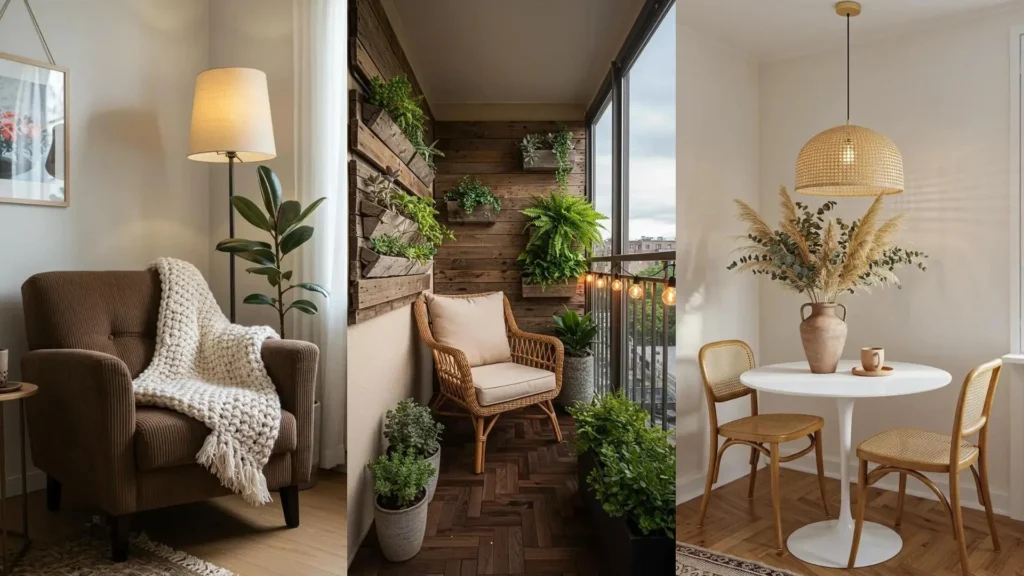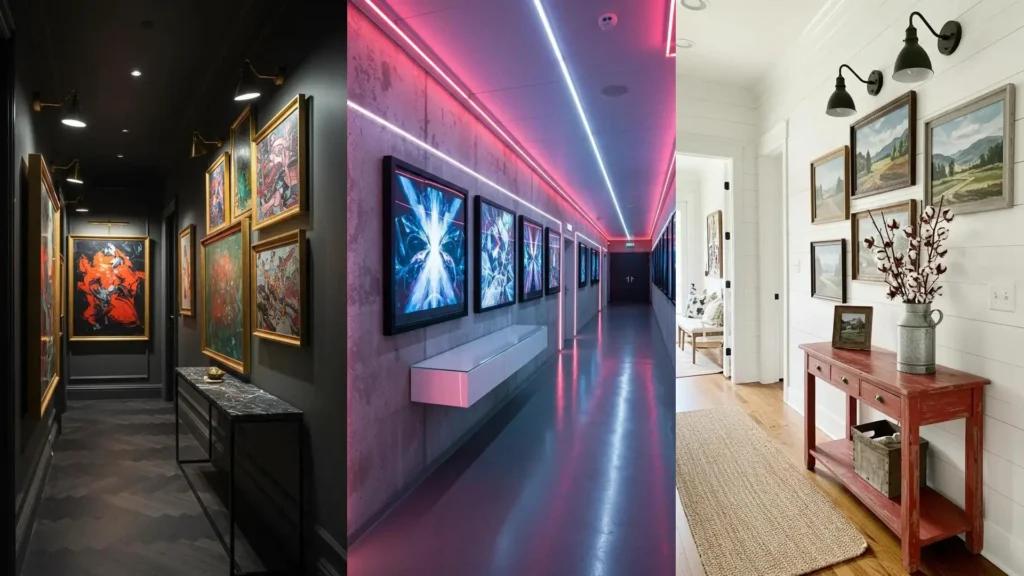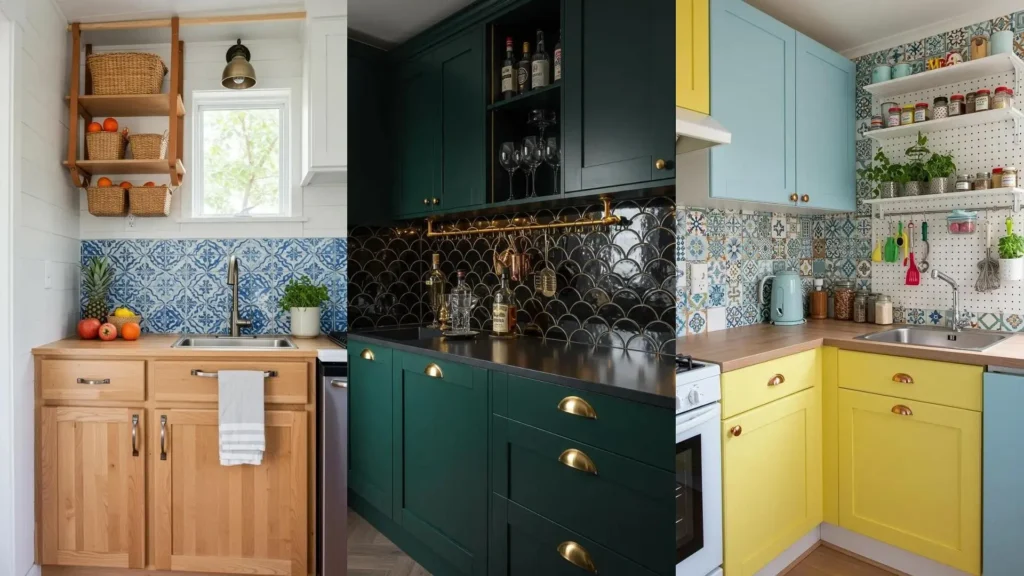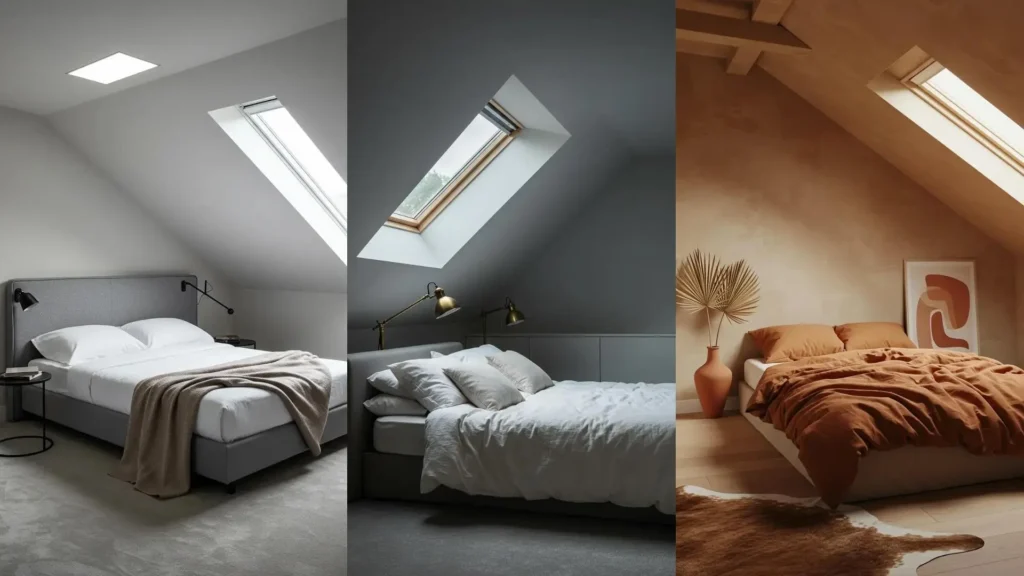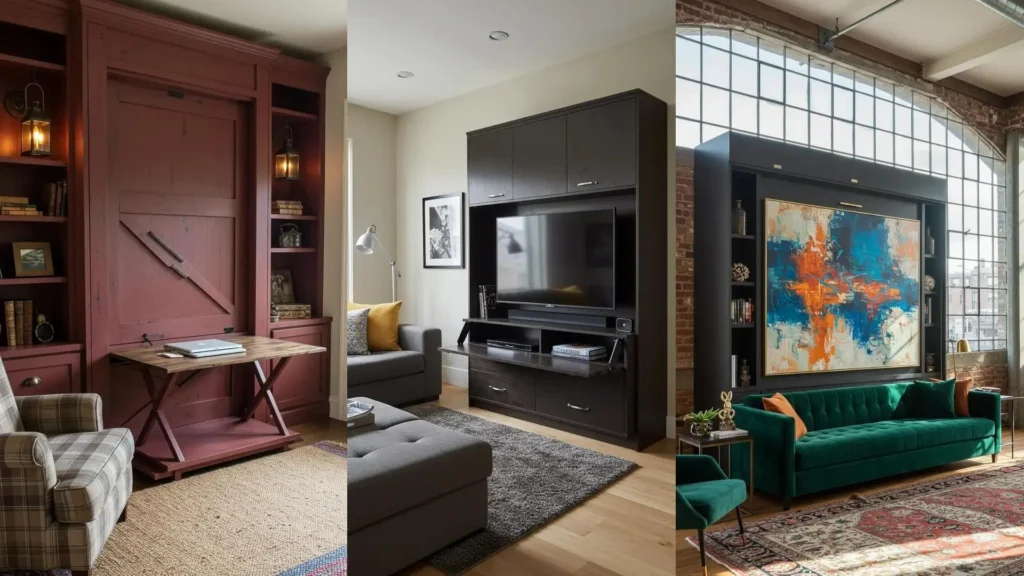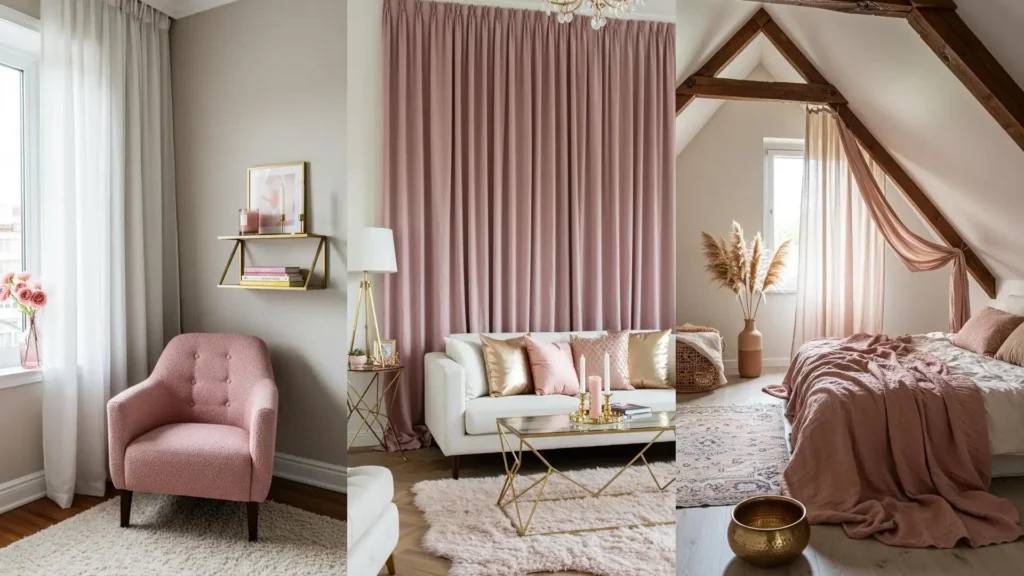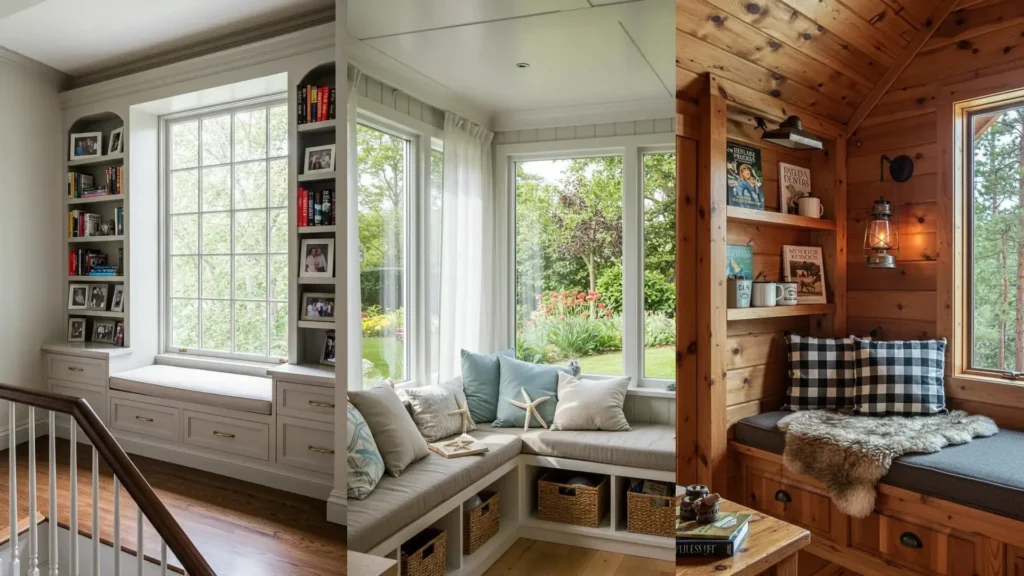Bringing the beauty of the outdoors into a small home can feel like a challenge. How do you add plants, texture, and color without making your space feel crowded or chaotic?
The answer is to look to nature itself as your guide. Nature’s palettes are inherently calming, its textures are varied and interesting, and its forms are perfectly imperfect. By borrowing these elements with intention, you can create a home that feels not just bigger, but more serene, cohesive, and deeply personal.
Here, I will show you exactly how to apply these principles. These are not vague ideas, but specific, actionable steps you can take right now to transform every room into a space that breathes.
1. Ground Your Space with an Earthen Accent Wall
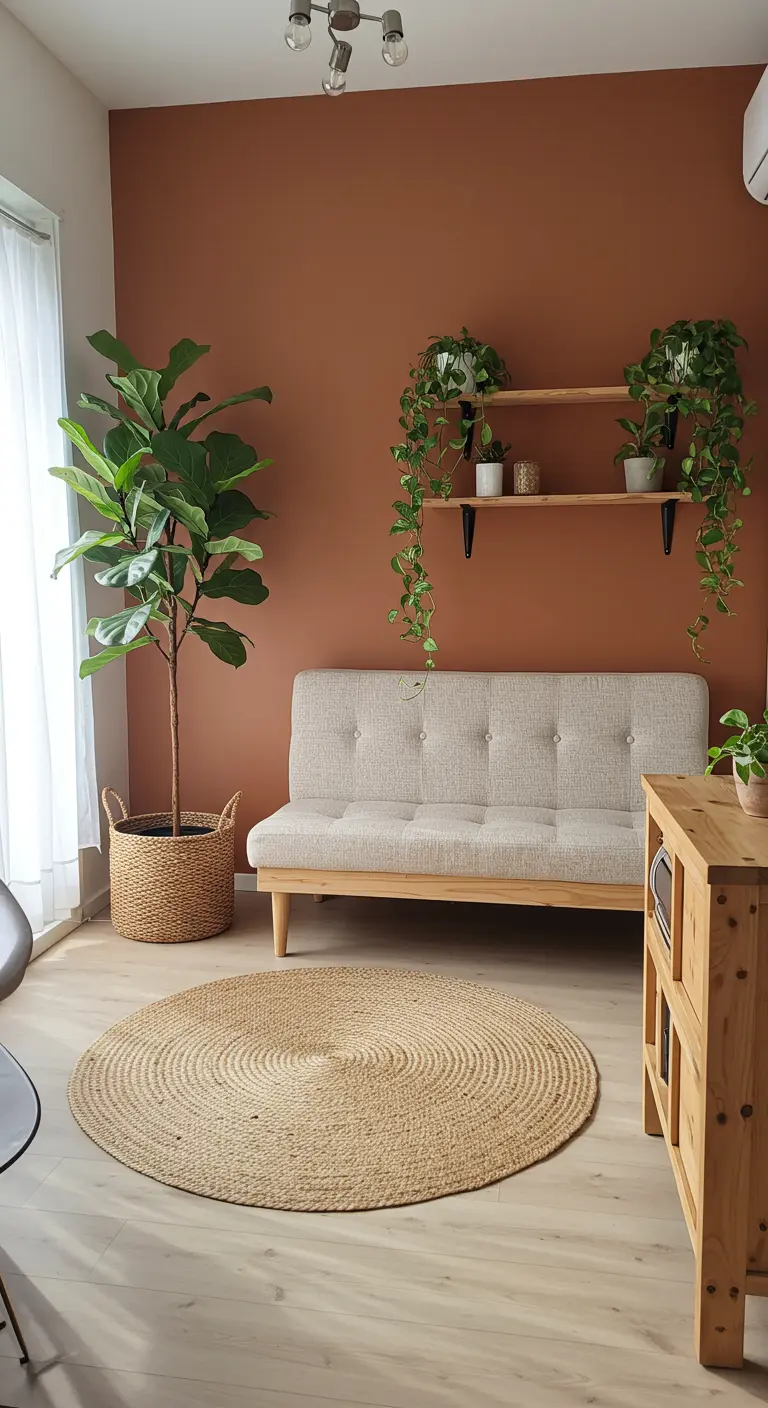
Instead of painting an entire room, select one wall to feature a warm, earthy color like terracotta or ochre.
This creates a powerful focal point without overwhelming a small space, making the room feel intentional and anchored.
Balance the rich color with light wood furniture, a natural fiber rug like jute, and plenty of greenery to ensure the result is grounding, not heavy.
This approach works especially well for defining a specific zone, such as your primary seating area.
For more inspiration, explore these warm earth tone rooms that feel both modern and timeless.
2. Cultivate Calm with Muted Green Walls
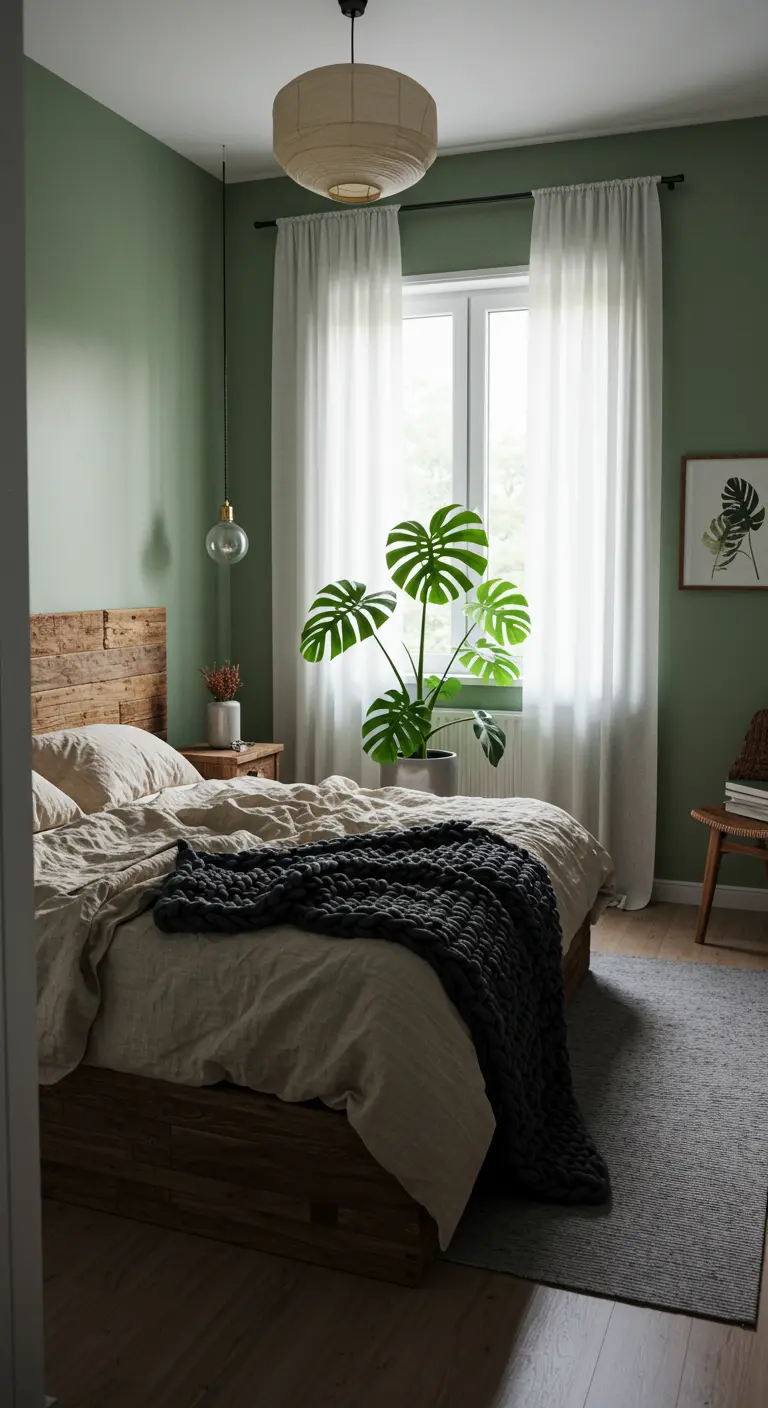
Choose a soft, desaturated green like sage or olive for your bedroom walls to create an instant sense of tranquility.
This color evokes nature and promotes restfulness, making it ideal for a sleep space.
Keep it from feeling too dark by pairing it with breezy, off-white curtains that maximize natural light and furnishings made of reclaimed or light-toned wood.
A single, sculptural plant, like a Monstera, becomes a living piece of art against the serene backdrop. This is one of the key elements in creating a romantic bedroom layout.
3. Create a Living Windowsill Herb Garden
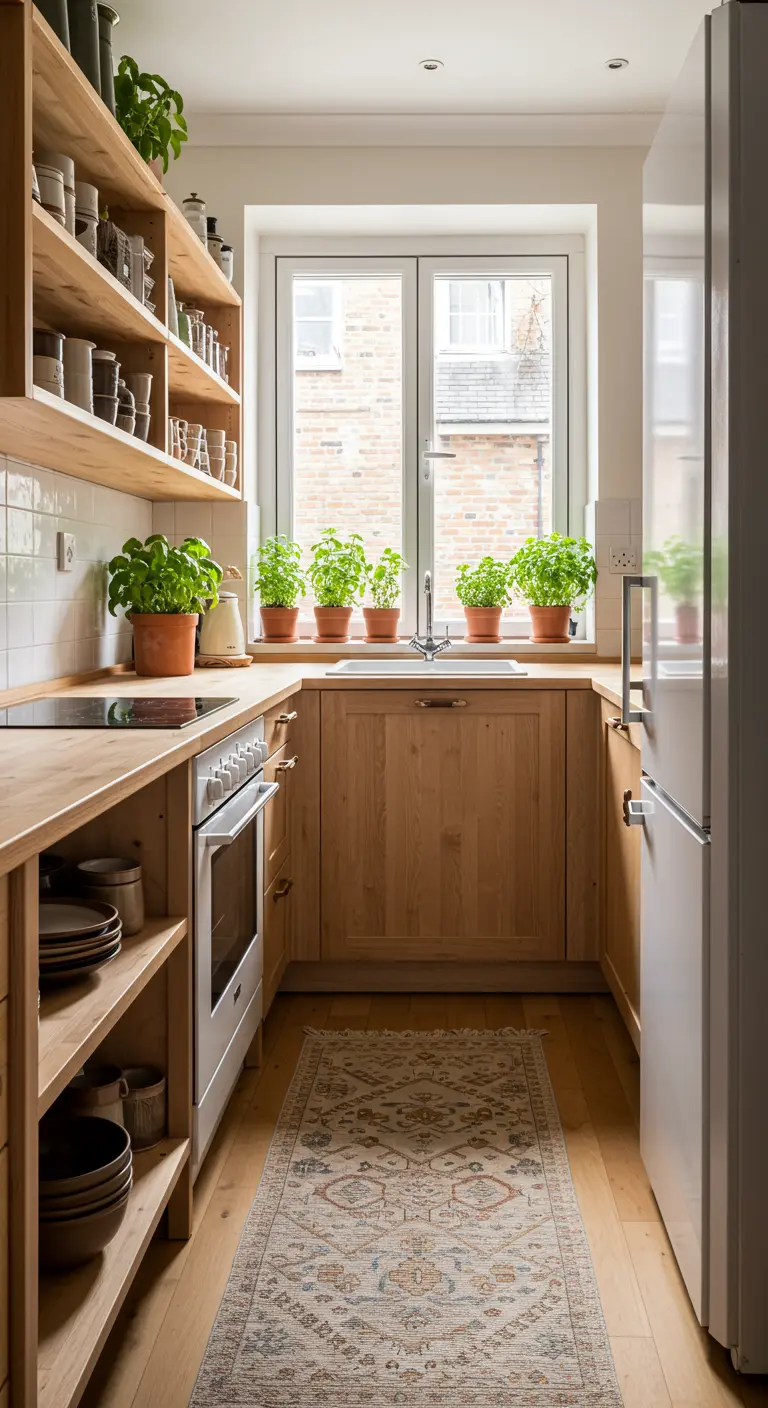
In a small kitchen, utilize your windowsill as a functional herb garden.
Line up several small terracotta pots with basil, mint, and rosemary. This not only adds fresh greenery but also provides ingredients right where you need them.
Open shelving in natural wood keeps the space from feeling boxed in, allowing you to display ceramics and everyday dishes beautifully. It’s a signature of many Country French kitchens.
A patterned runner rug adds softness underfoot and introduces a touch of color and personality.
4. Maximize Vertical Space on a Small Balcony
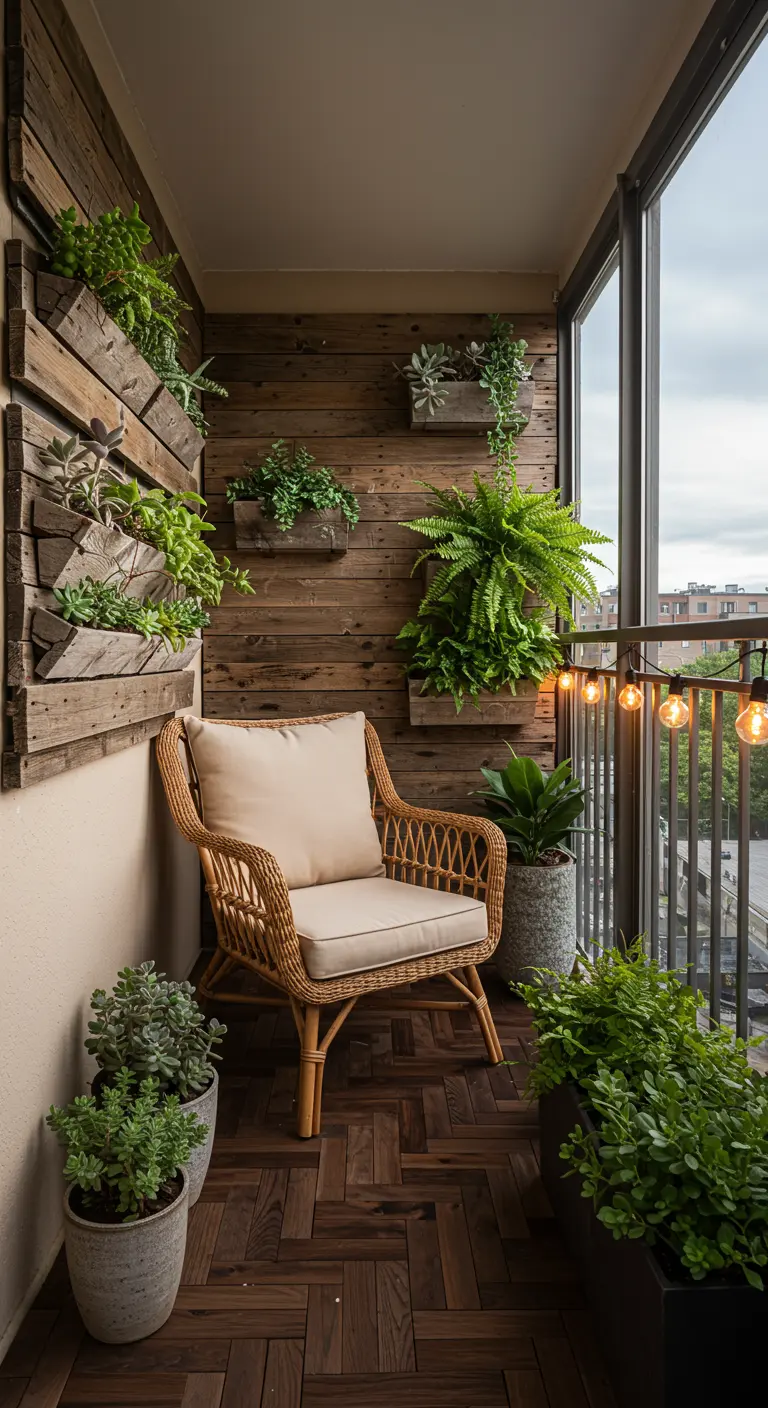
When floor space is limited, think vertically.
Install reclaimed wood planters directly onto a balcony wall to create a lush, living feature that draws the eye upward.
Mix different types of plants—cascading ferns, upright succulents—for varied texture and visual interest.
A natural wicker or rattan chair adds a comfortable, organic element, turning even the smallest outdoor area into a private escape. These balcony gardens with privacy screens offer even more ideas for creating your own oasis.
5. Curate a Calm and Natural Workspace
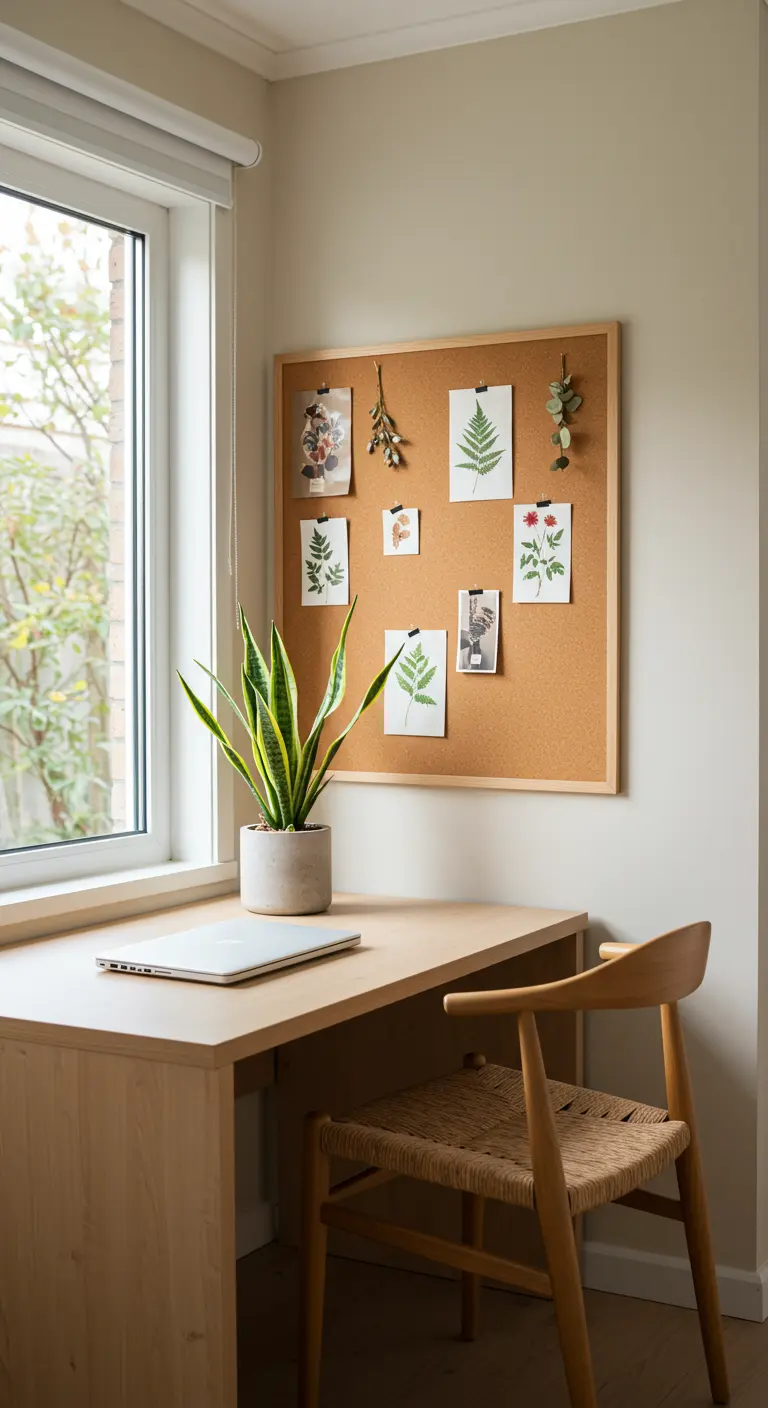
Design a home office corner that feels focused and serene, not cluttered.
Mount a simple corkboard above your desk to act as a textural, warm alternative to a cold whiteboard. Use it to pin botanical prints and notes, blending organization with natural beauty.
A simple wood desk and woven chair continue the theme, while a single, easy-care snake plant in a ceramic pot adds life without demanding too much attention.
This minimalist approach helps keep your mind clear and your space inspiring, an idea also seen in contemporary Zen homes.
6. Swap Your Towel Rack for a Bamboo Ladder
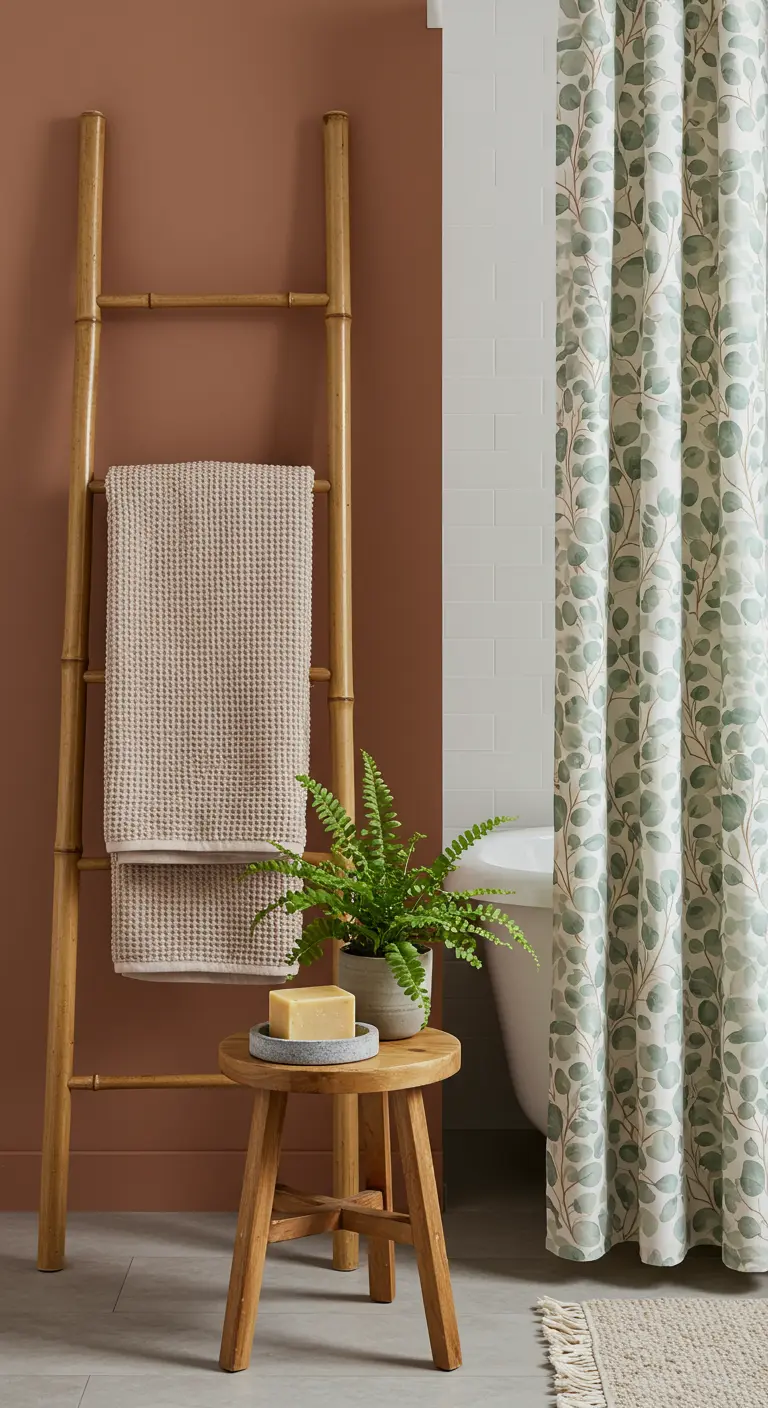
Introduce warmth and an unexpected silhouette into your bathroom with a bamboo ladder.
It serves the same function as a standard towel rack but adds far more character and a spa-like feel, leaning effortlessly against the wall.
Pair it with a waffle-weave towel for added texture and a shower curtain with a subtle botanical print to unify the nature-inspired theme.
This simple swap requires no installation and instantly elevates the entire room, similar to the ideas in these Zen garden bathrooms.
7. Design an Entryway That Is Both Light and Organized

In a narrow entryway, avoid bulky furniture that closes the space in.
Instead, install two floating wood shelves. The top shelf can hold a mirror and decorative objects, while the bottom one is perfect for shoe storage.
Use woven baskets to conceal clutter, keeping the area tidy and visually calm. A large, round mirror will bounce light around and create the illusion of more space.
For more ways to handle a compact entrance, see these clever ideas for tiny entryways.
8. Layer Textures for an Inviting Reading Nook

Create the perfect corner for relaxation by layering multiple soft and natural textures.
Start with a comfortable, upholstered armchair in a gentle color like dusty rose. Add a chunky hand-knit throw for tactile comfort.
Place a faux sheepskin or high-pile wool rug on the floor to define the space and add luxurious softness underfoot.
A rustic, live-edge wood side table provides an organic counterpoint to all the soft materials, perfect for holding a book and a warm mug.
These cozy corners for small rentals show just how impactful this technique can be.
9. Define a Dining Nook with a Woven Pendant

Even the smallest corner can become a designated dining area with the right lighting.
Hang a large, woven rattan or bamboo pendant light over a small bistro table. This single element anchors the space and draws the eye, making it feel like a distinct ‘room’.
Choose chairs with cane or woven details to echo the texture of the light fixture, creating a cohesive, airy look.
An arrangement of dried grasses and eucalyptus in an earthenware vase adds lasting beauty without requiring maintenance. This concept is central to many charming dining corners.
10. Treat a Plant as a Sculptural Centerpiece
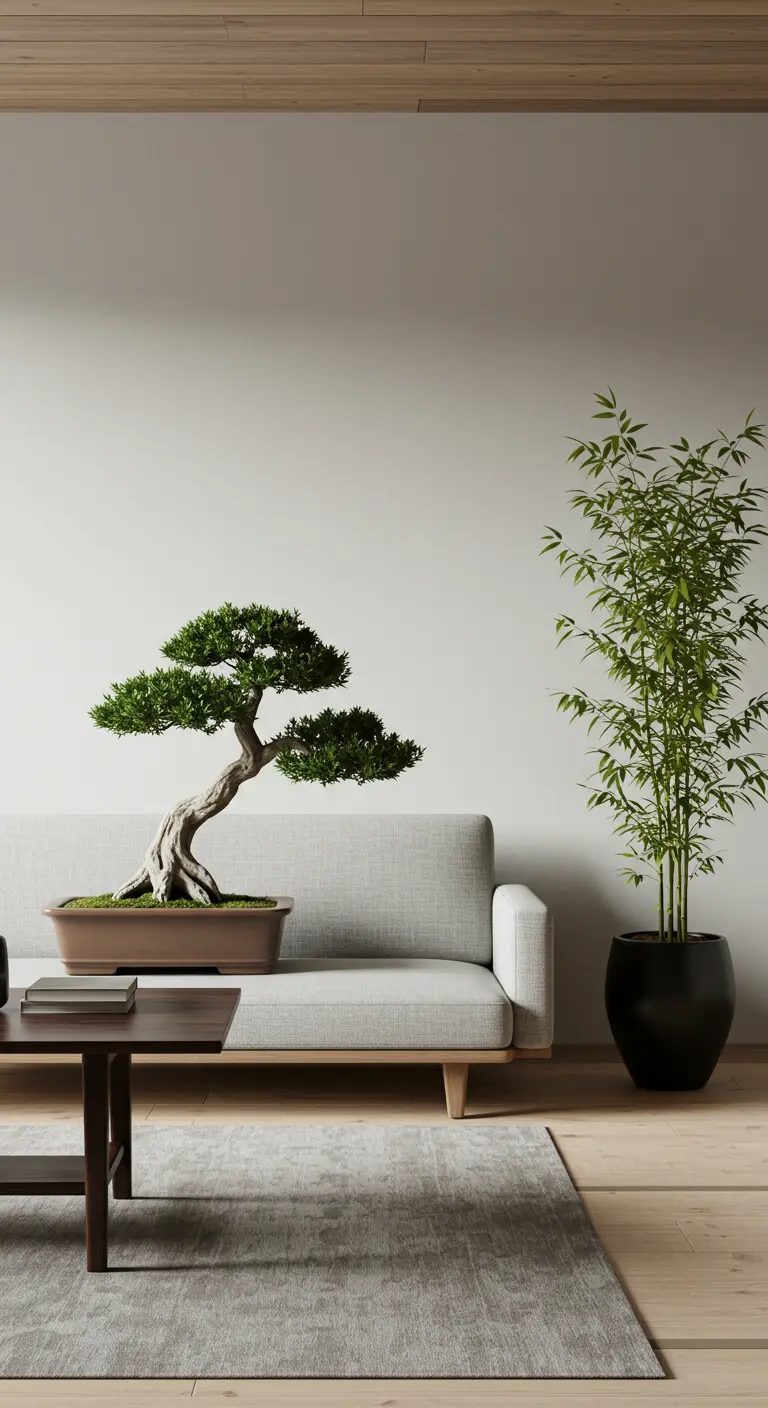
In a minimalist space, choose one plant to serve as living art.
A bonsai tree, with its gnarled trunk and carefully shaped foliage, has a powerful sculptural presence that commands attention.
Place it off-center on a console or next to a sofa and keep the surrounding decor simple and neutral. This allows its organic form to become the undisputed focal point of the room.
This principle of less-is-more is a hallmark of coastal minimalism, where every piece is chosen with intention.
11. Add Depth with a Textured Plaster-Effect Wall
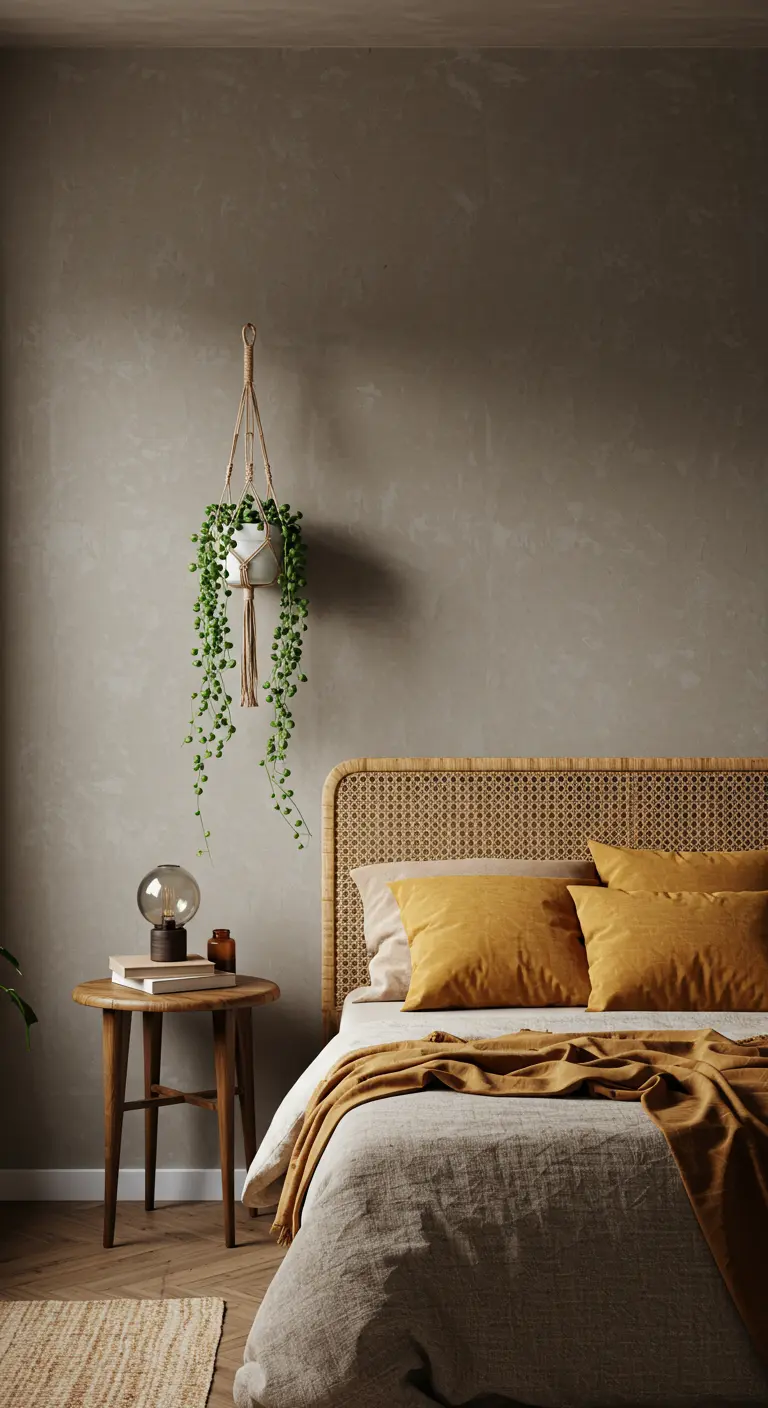
If you crave visual interest without busy patterns, consider a textured wall finish like limewash or Roman clay.
The subtle variations in tone and texture add incredible depth and a soft, luminous quality to the room.
In a bedroom, this creates a soothing, cocoon-like atmosphere. Pair it with a rattan headboard and a simple hanging plant to complete the organic, layered look.
Rich, mustard-yellow pillows provide a perfect, earthy color accent against the neutral backdrop, a technique often seen in desert-inspired interiors.
12. Unify a Gallery Wall with a Botanical Theme
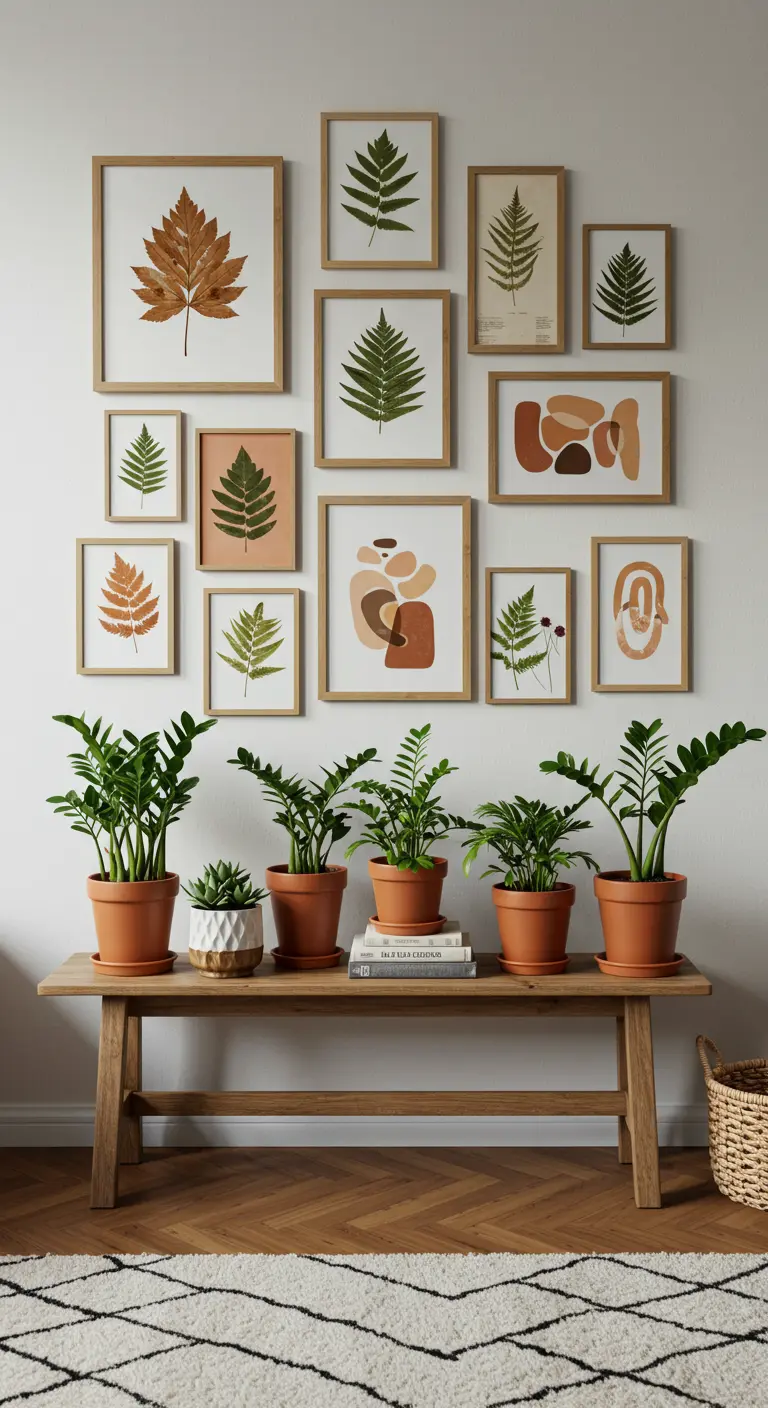
Create a high-impact gallery wall with ease by sticking to a single, cohesive theme.
Gather a collection of pressed leaf prints and simple, abstract shapes in earthy tones. Frame them all in identical light wood frames for a clean, unified appearance.
Arranging them in a loose grid above a bench or console table grounds the collection and makes it feel intentional.
Placing a row of potted plants below connects the artwork to the living elements in the room. This curated approach is perfect for eclectic home designs.
13. Layer Patterns within a Cohesive Color Story
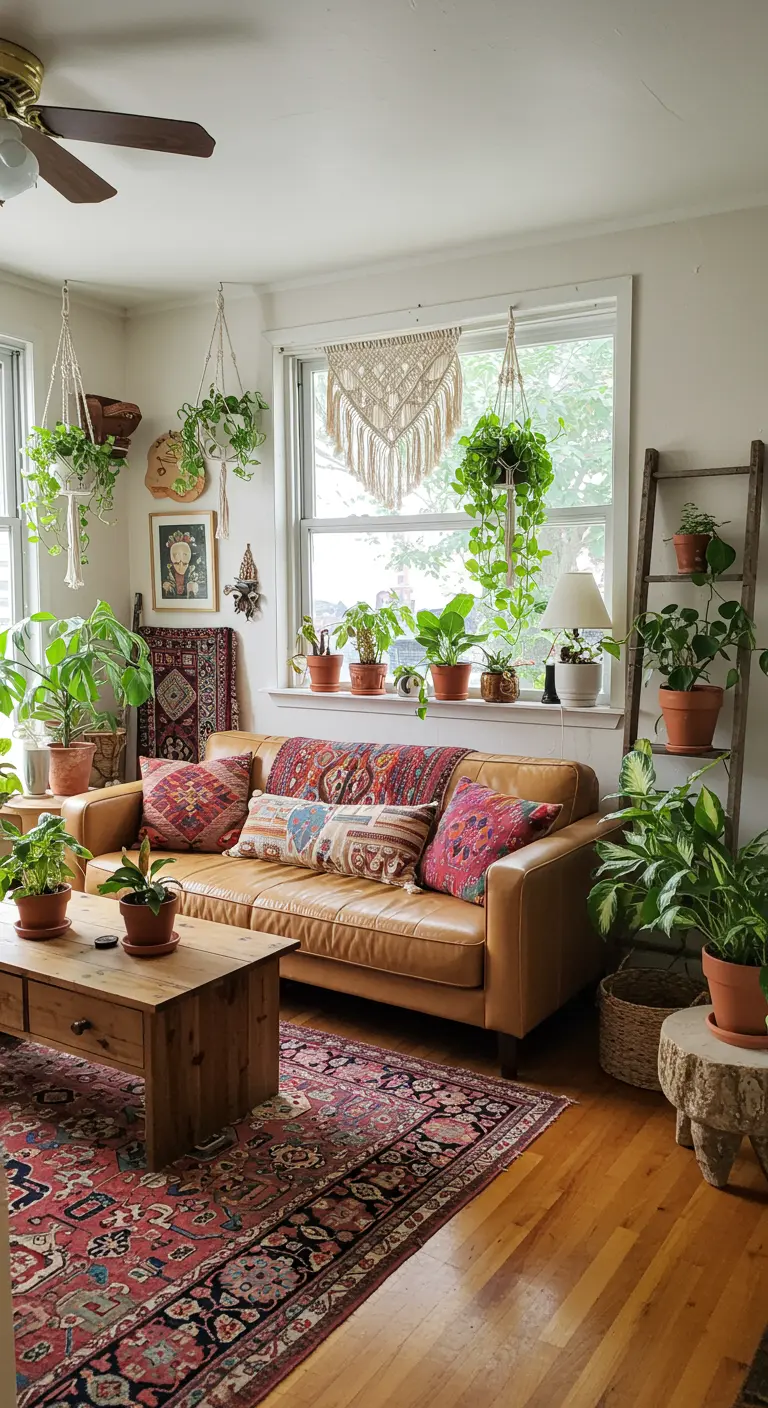
Successfully mix multiple patterns and textures by anchoring them with a unified color palette.
In this living room, various kilim, ikat, and block-print patterns on the rug and pillows work together because they all share a warm base of reds, pinks, and creams.
The leather sofa provides a solid, neutral foundation, while an abundance of hanging and potted plants injects life and breaks up the density of the patterns.
A macrame wall hanging adds another layer of handmade texture, enhancing the room’s collected, bohemian feel. This layering is similar to what you’d find in bright eclectic studios.
14. Use Deep, Saturated Color in a Small Kitchen
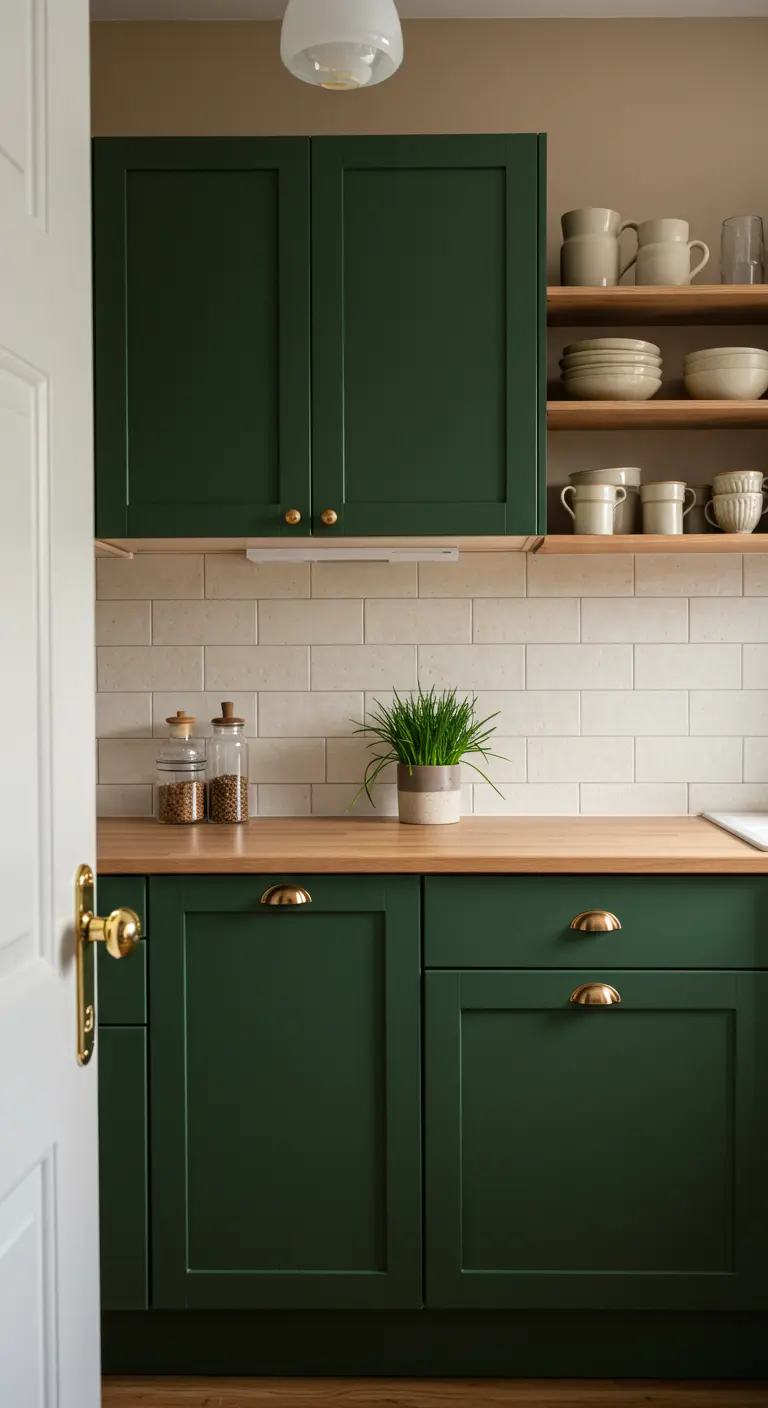
Do not be afraid of dark colors in a compact kitchen. A deep forest green on the cabinetry can feel incredibly chic and sophisticated.
The key to making it work is balance. Pair the dark cabinets with a light-colored backsplash, like these off-white subway tiles, and warm wood countertops.
Brass or gold hardware adds a touch of warmth and reflects light, preventing the space from feeling too heavy. Similar bold choices can be found in modern gothic kitchens.
15. Designate a Corner for Stillness and Reflection
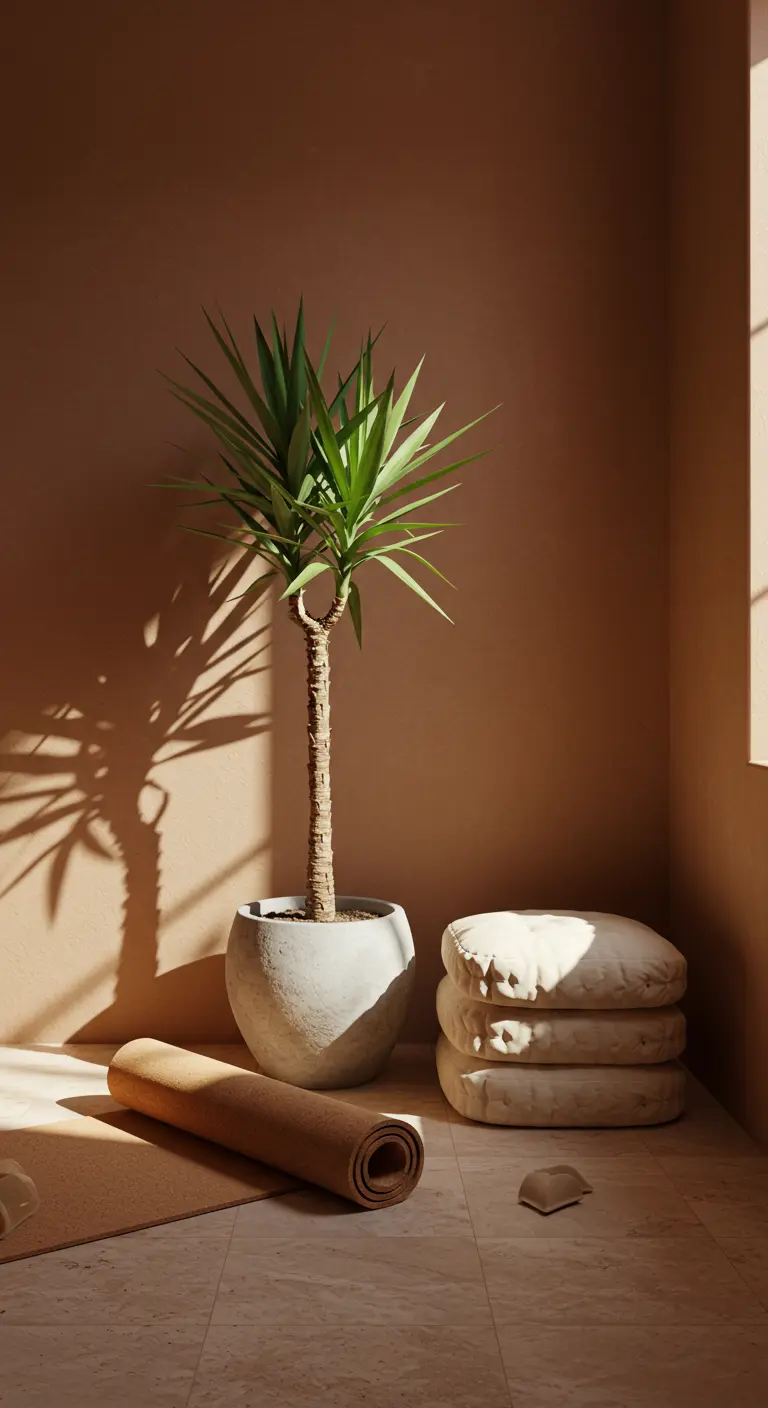
Carve out a small corner dedicated to quiet activities like yoga or meditation, even if you don’t have a separate room.
Define the area with a simple cork yoga mat and stackable linen floor cushions. The color palette should be muted and calming, like this sun-baked beige.
A single, sculptural plant like a Yucca in a rustic stone pot adds a strong, natural element that enhances the space’s serene purpose. This is the essence of creating a desert oasis at home.
16. Install a Plant Ledge for a Wall of Greenery
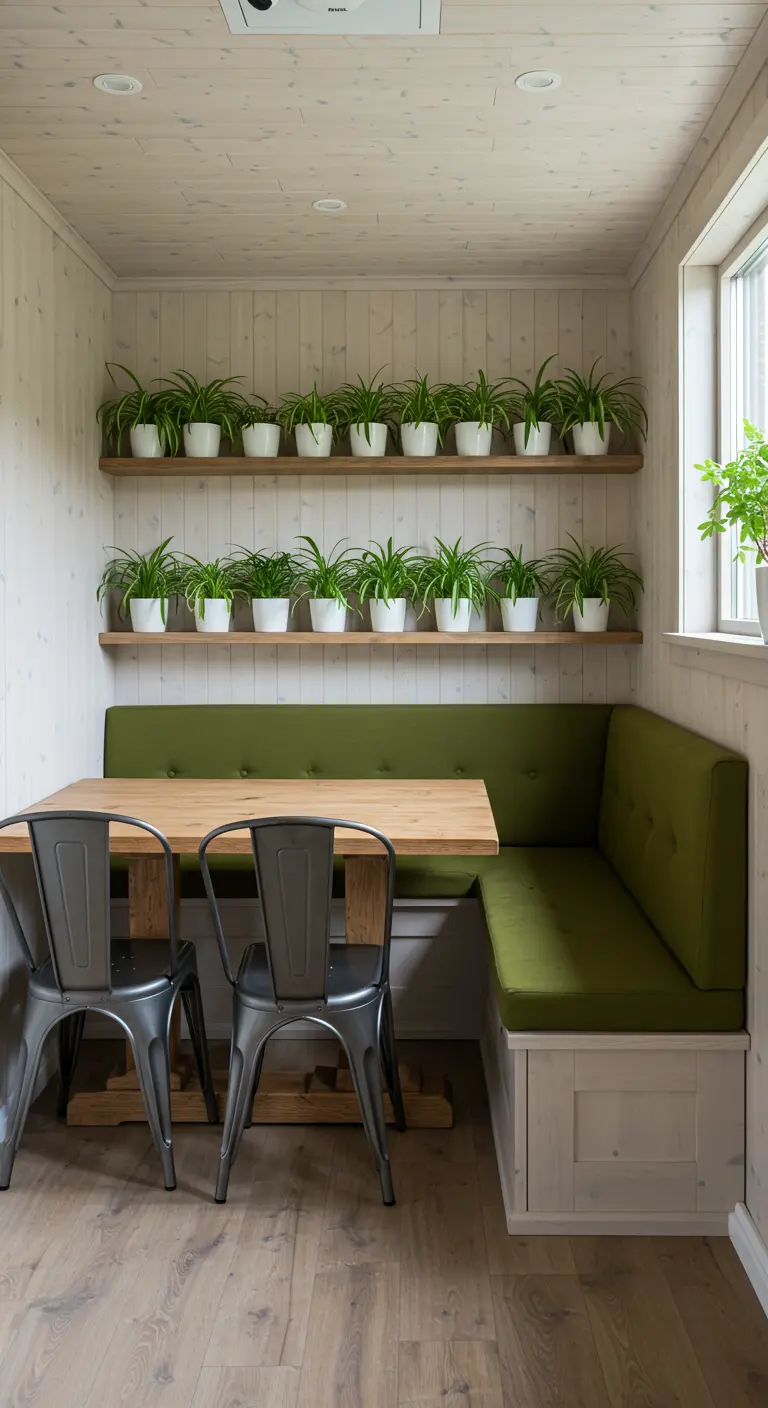
Create the effect of a living wall with a simple, high-impact solution: a plant ledge.
Install a long, narrow shelf above a banquette or along a blank wall and fill it with a symmetrical arrangement of identical plants, like these spider plants.
This creates a clean, intentional ribbon of green that adds immense life and visual interest without cluttering surfaces below. It’s a clever trick often used in Scandinavian hygge dining rooms.
17. Master the Monochromatic Neutral Palette
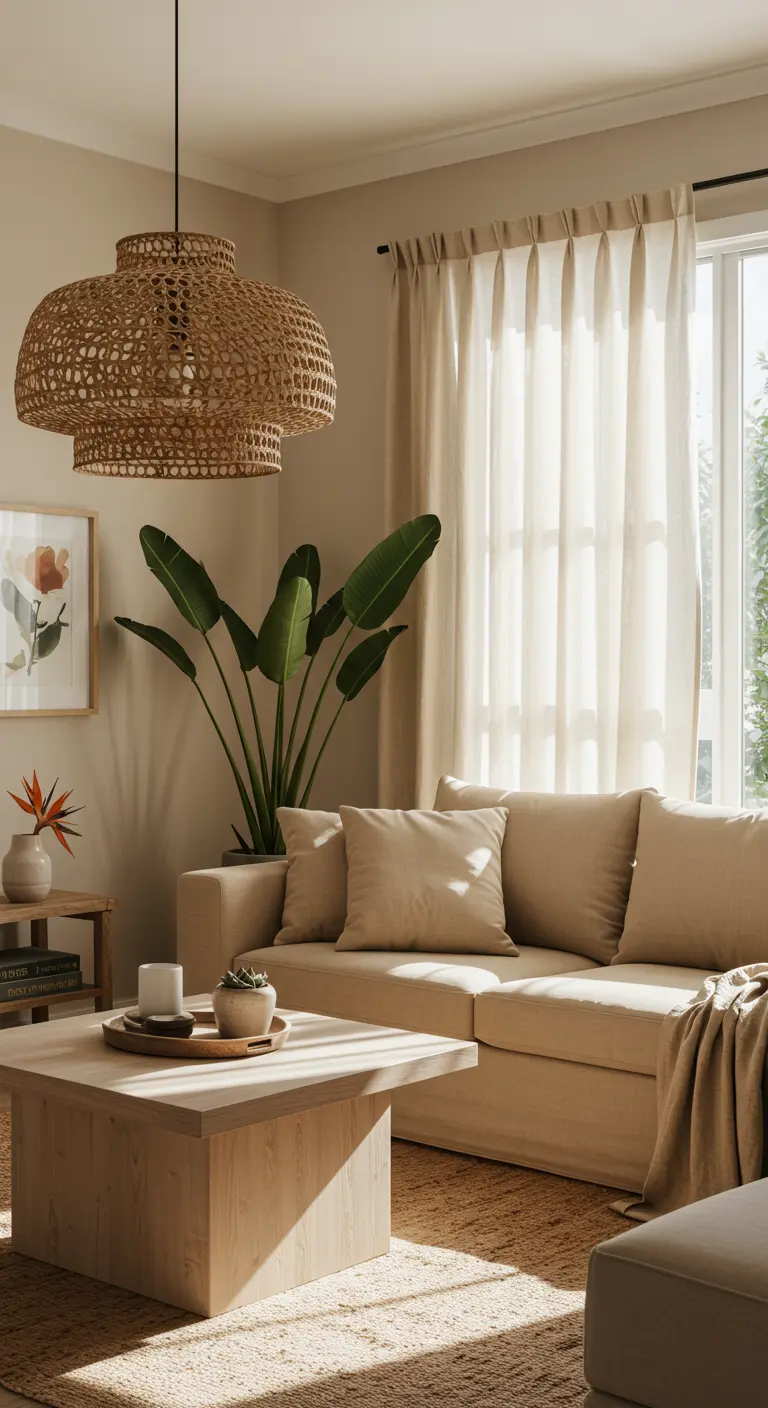
A room decorated entirely in shades of beige, cream, and sand can feel incredibly sophisticated and serene, not boring.
The secret is to introduce a rich variety of textures. Combine a soft, slipcovered sofa with sheer linen curtains, a chunky woven jute rug, a smooth raw-wood coffee table, and the glossy leaves of a large Bird of Paradise plant.
Each element reflects light differently, creating a layered, interesting space that feels calm and cohesive. This refined look is a cornerstone of subtle neutralscape rooms.
18. Create an Intimate Space with a Bed Canopy
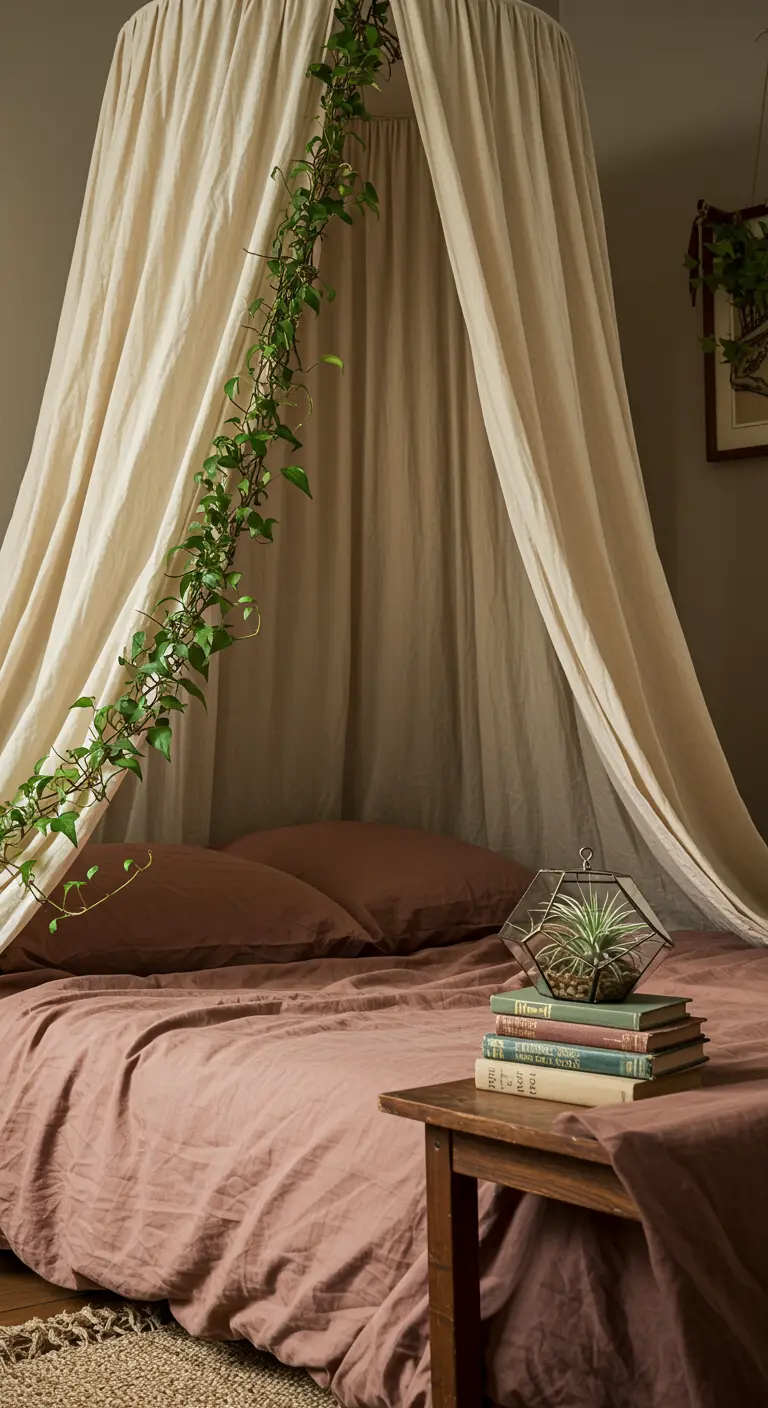
A simple ceiling-mounted canopy can transform your bed into a cozy, intimate sanctuary.
Choose a lightweight, breathable fabric like cotton or linen in a neutral color to keep the effect airy and romantic, not confining.
For a touch of living magic, gently weave a single, long vine of ivy or pothos around the fabric, letting it drape naturally. This connects your sleeping space directly to nature and feels wonderfully whimsical.
This idea can bring to life the room of your dreams, much like these ethereal pastel bedroom inspirations.
19. Optimize a Small Bedroom with Smart Storage
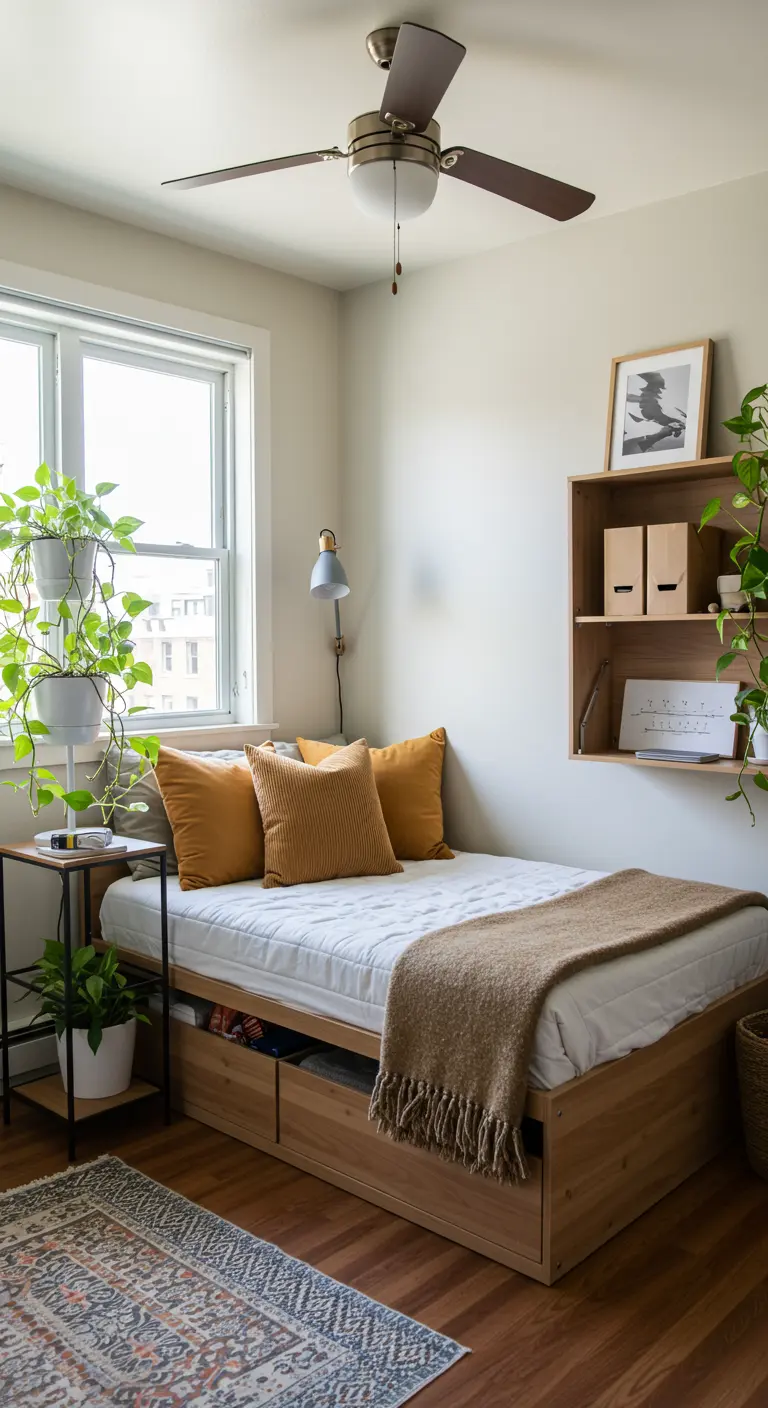
In a compact bedroom or studio, every piece of furniture must work hard.
Select a bed frame with built-in drawers underneath—it’s the perfect place to store extra linens, seasonal clothing, or shoes, eliminating the need for a bulky dresser.
Use vertical space with floating wall shelves instead of a traditional nightstand. This keeps the floor clear and makes the room feel more open.
This type of smart design is essential for flexible furniture layouts in small spaces.
20. Embrace Drama with a Moody, Dark Bathroom
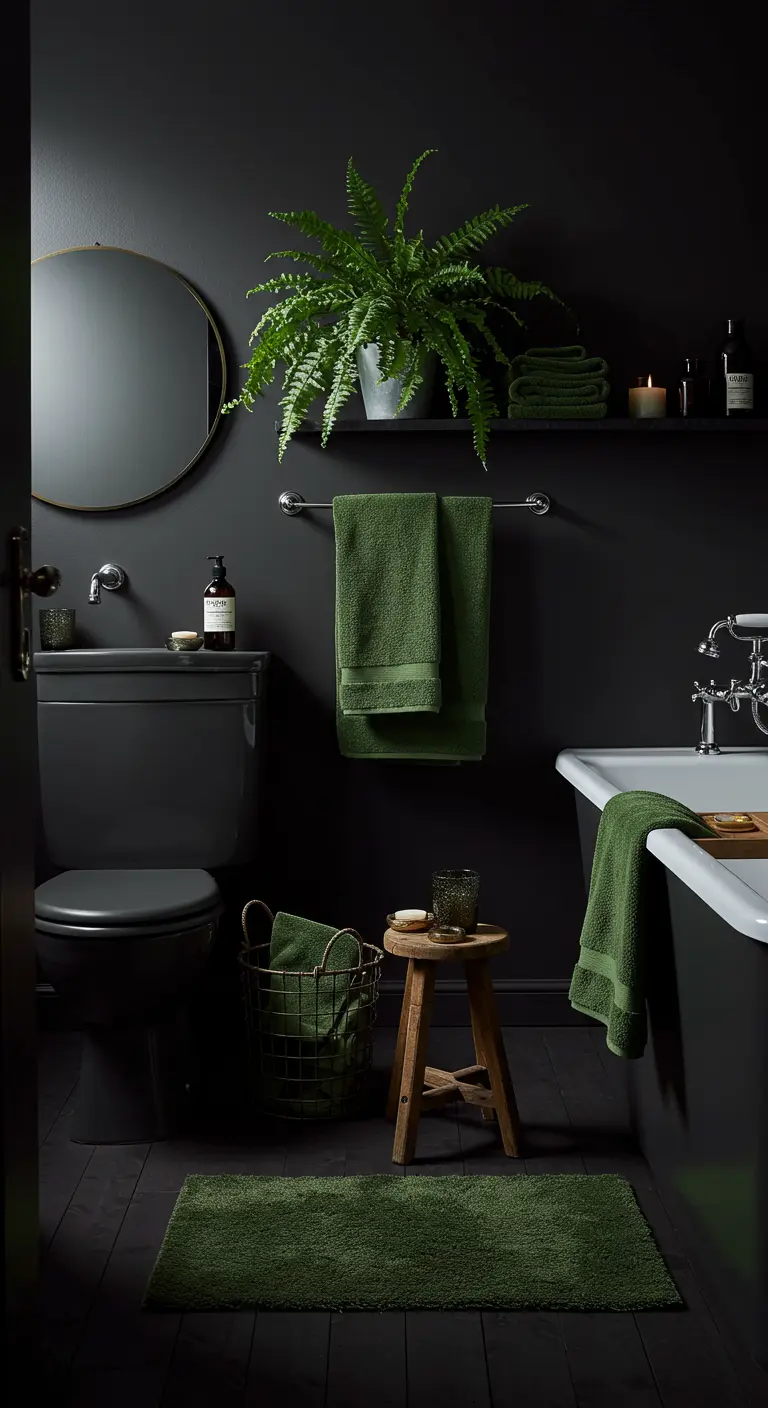
Counterintuitively, a dark, matte color palette can make a small bathroom feel incredibly intimate and luxurious.
Commit to a single shade, like this charcoal black, for the walls, toilet, and even the vanity. This monochromatic approach blurs the room’s edges, making it feel less confined.
Introduce vibrant, deep green through lush ferns and plush cotton towels. The organic color pops against the dark background, creating a dramatic, high-contrast look that feels intentional and bold. You can achieve similar effects with bold color-blocked tiles.
21. Transform a Sunroom into a True Conservatory
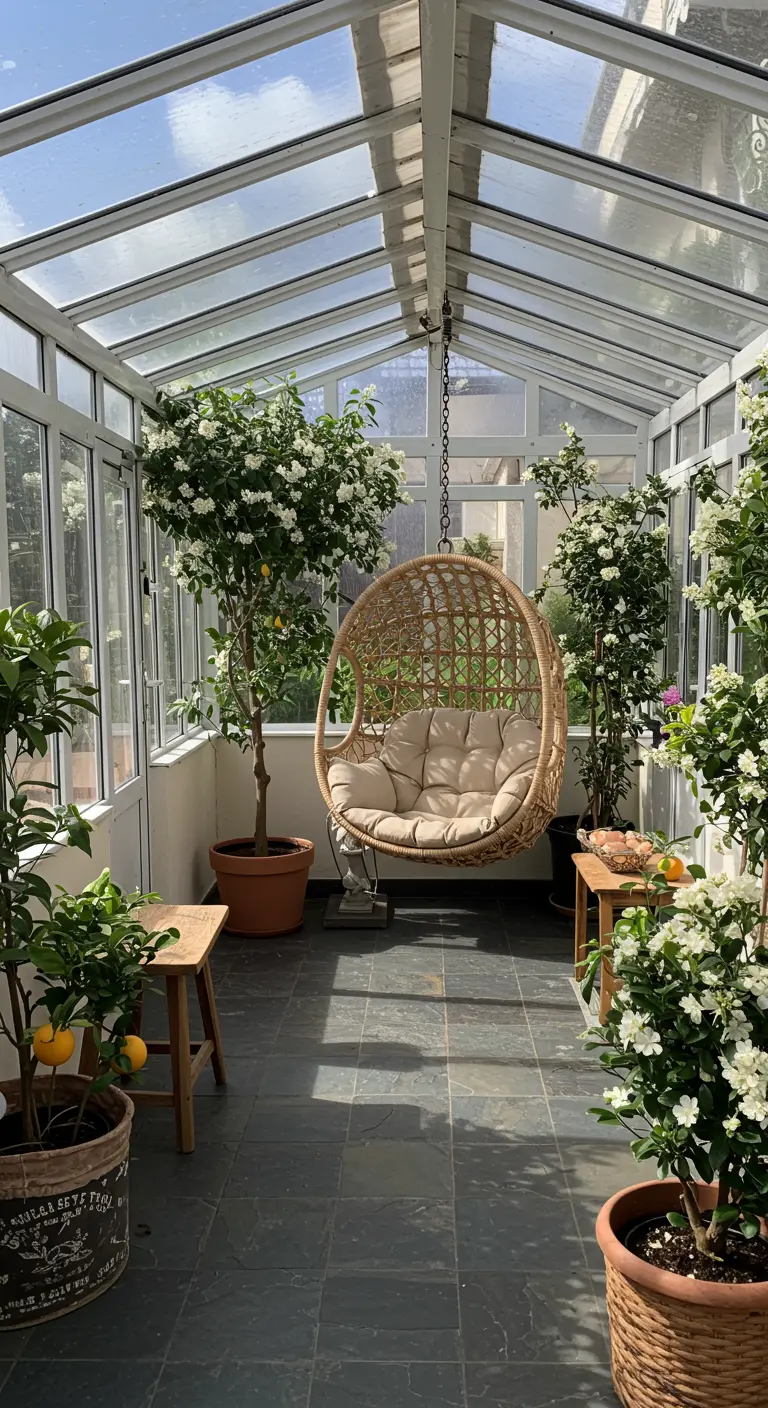
If you are lucky enough to have a sunroom, treat it as a true indoor garden.
Instead of just a few scattered plants, group several large-scale specimens like flowering citrus trees to create an immersive, conservatory feel.
A hanging egg chair made of natural rattan provides the perfect spot to sit and enjoy your private oasis. The slate tile floor is a practical choice that can handle watering and feels connected to the outdoors.
This is the ultimate in urban garden escapes.
22. Define Zones with a Textural Folding Screen
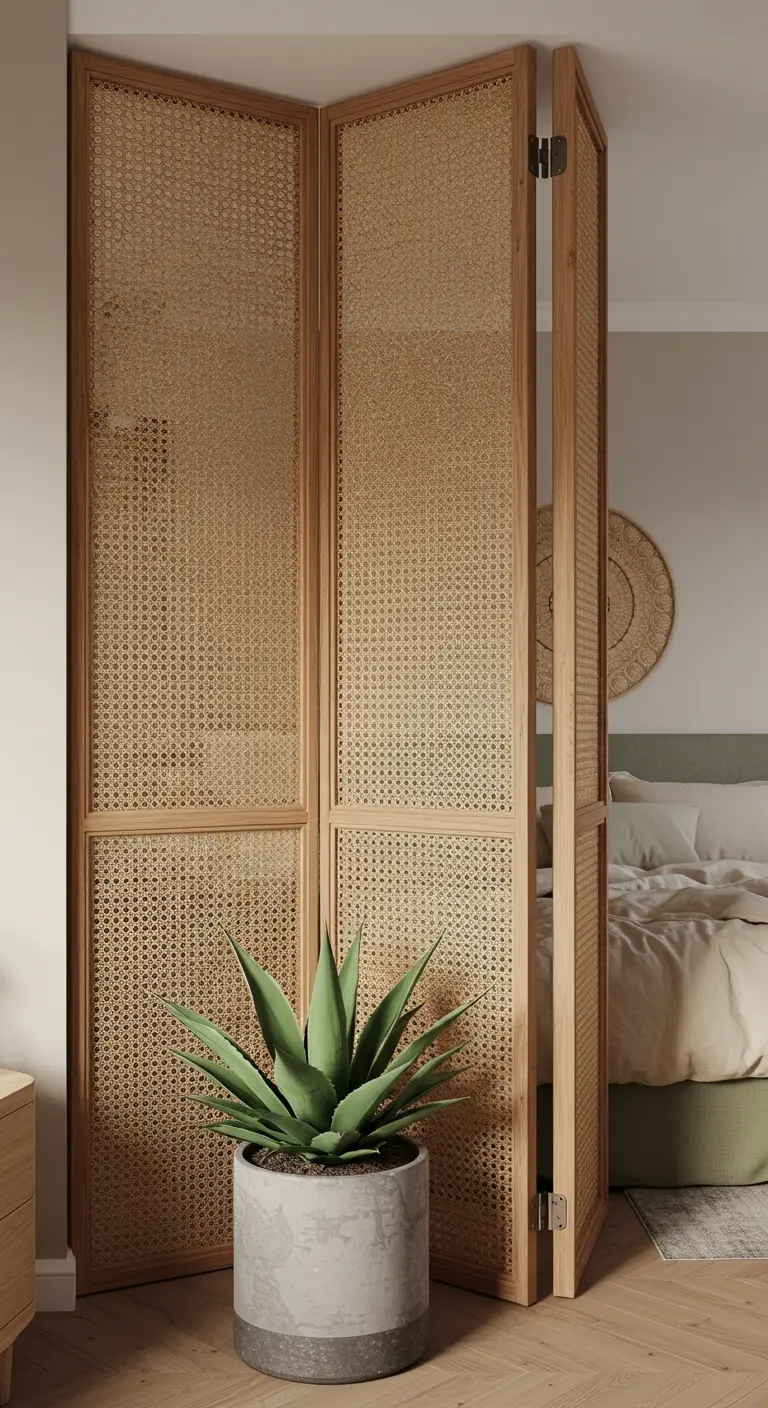
In a studio apartment or an open-plan room, you can create the feeling of separation without building a wall.
Use a freestanding folding screen with cane or rattan webbing to visually divide your sleeping area from your living space.
The woven texture adds a beautiful, natural element, and its semi-transparent nature allows light and air to pass through, so the space remains bright and open while still feeling thoughtfully zoned. It’s an elegant solution for creating coastal-inspired spaces.
23. Balance Technology with Substantial Natural Forms
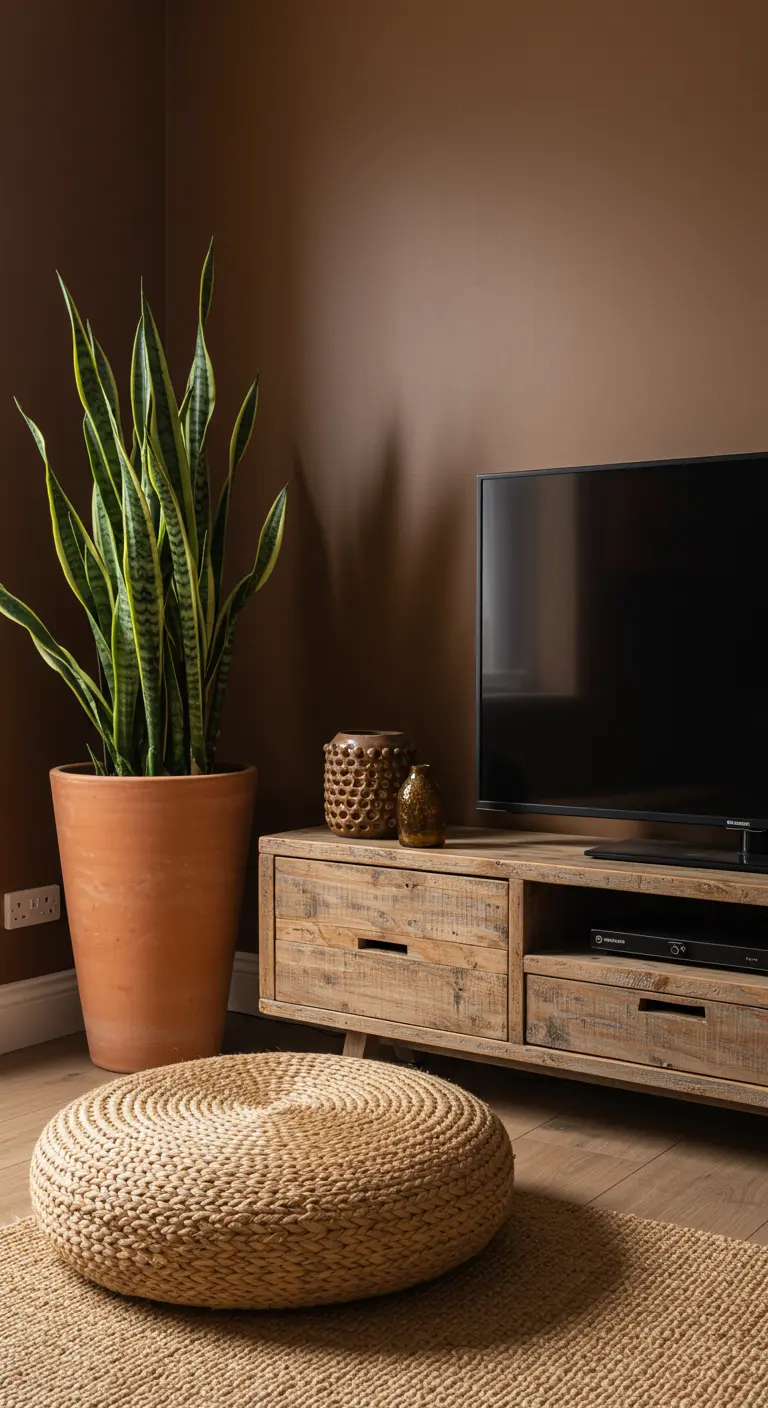
Soften the hard lines of a television and media console by grounding the area with significant natural elements.
Place a large, sculptural snake plant in a substantial terracotta pot next to the console. Its height and organic shape provide a powerful counterpoint to the sleek, black screen.
Add a low, woven floor pouf nearby. This introduces another layer of soft, natural texture and helps the entire corner feel more integrated and balanced. Explore similar ideas in these modern rustic living rooms.
24. Elevate Existing Finishes with Curated Details
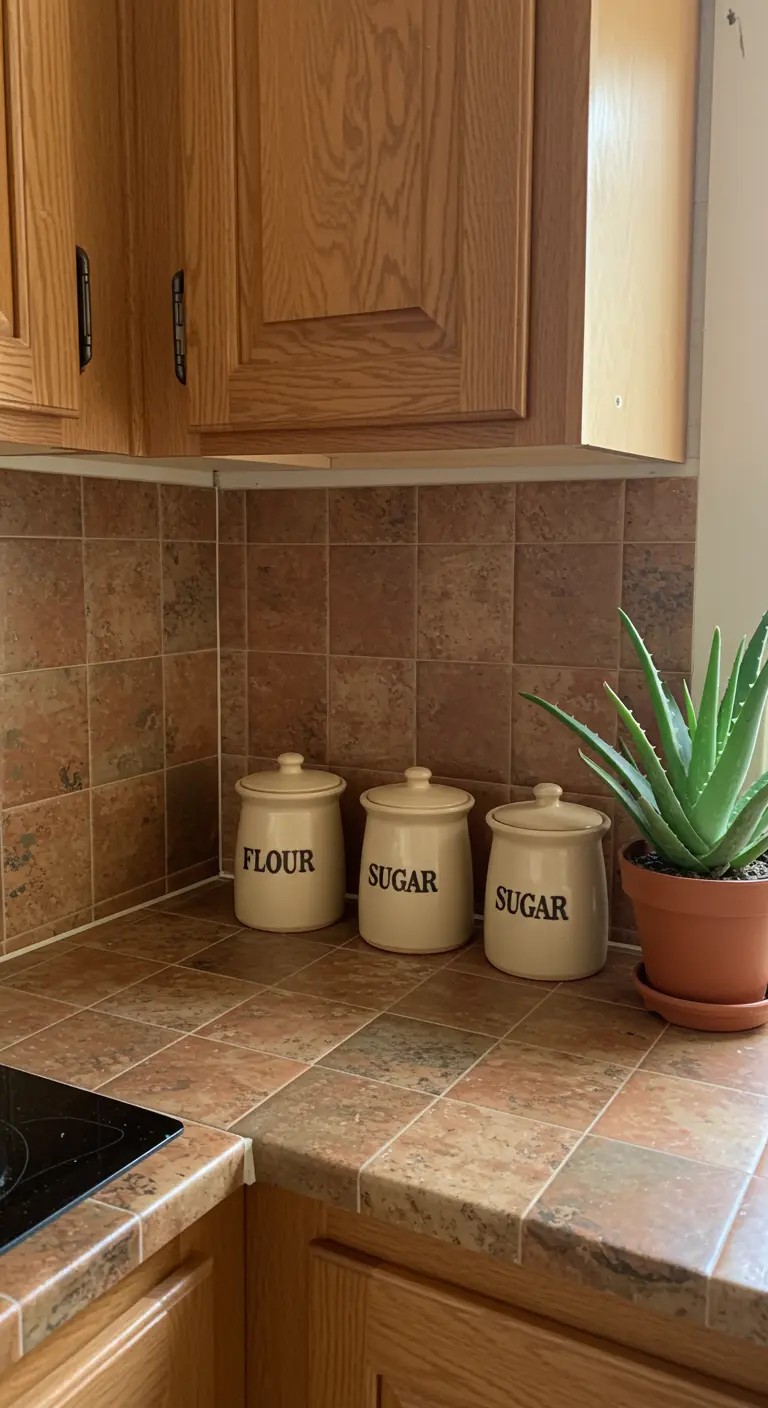
You don’t need a full renovation to improve your kitchen. Focus on small, thoughtful upgrades.
If you have dated tile countertops, draw attention away from them with beautiful, functional objects.
A set of matching ceramic canisters for flour and sugar feels classic and intentional. Placing a healthy aloe vera plant in a simple pot on the counter adds a touch of green life and breaks up the expanse of tile.
These small additions bring a sense of purpose and care to the space. Find more inspiration in upcycled DIY decor.
25. Capture a Desert Vibe with Warmth and Simplicity
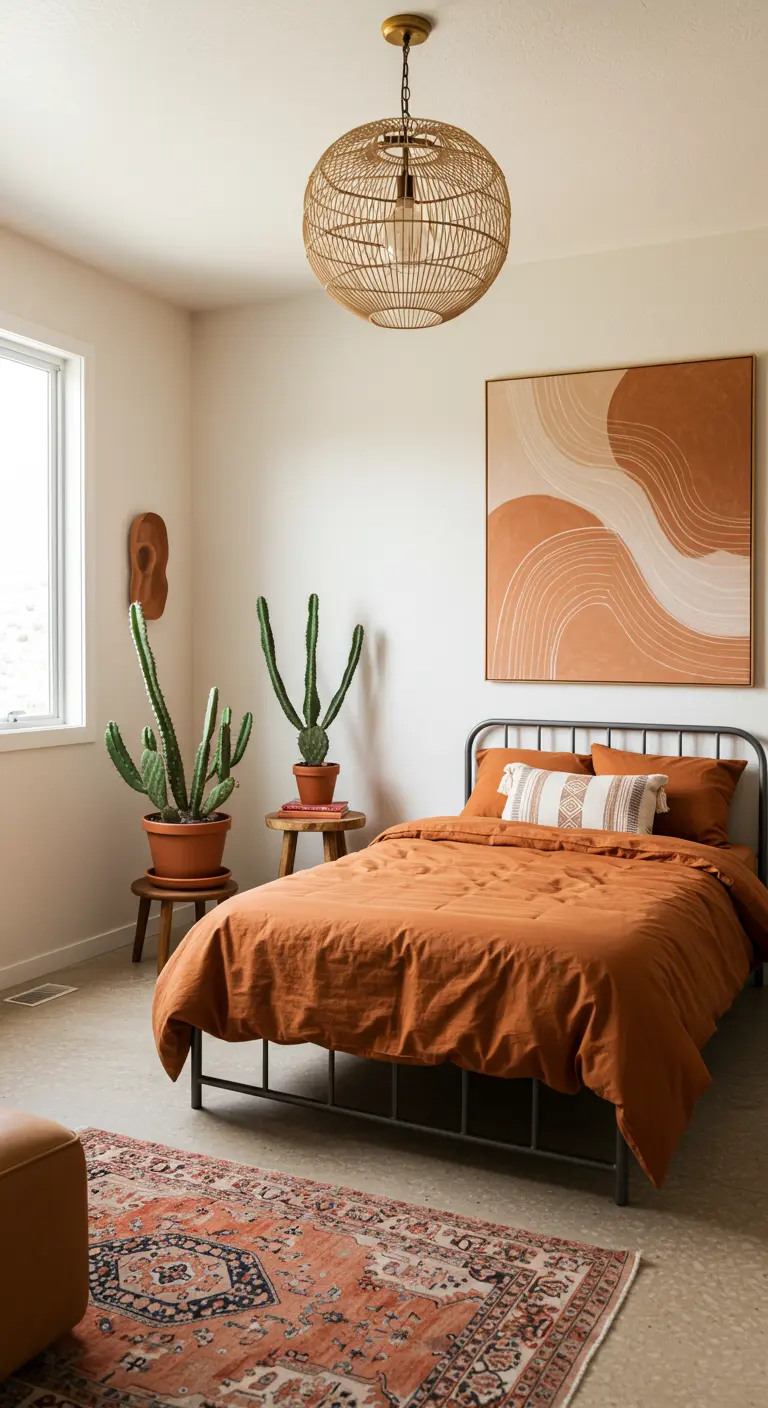
Create a bedroom that feels like a warm, sun-drenched escape using a desert-inspired palette.
Layer rumpled linens in shades of burnt orange and terracotta on the bed. Hang a large piece of abstract art with similar tones to anchor the color scheme.
Pair these warm colors with a simple, black metal bed frame. The clean lines prevent the room from feeling rustic or heavy.
A few sculptural cacti in terracotta pots are the perfect living accessories for this look, which you can see more of in these sunset-inspired bedroom schemes.
26. Make Your Entryway Both Practical and Welcoming
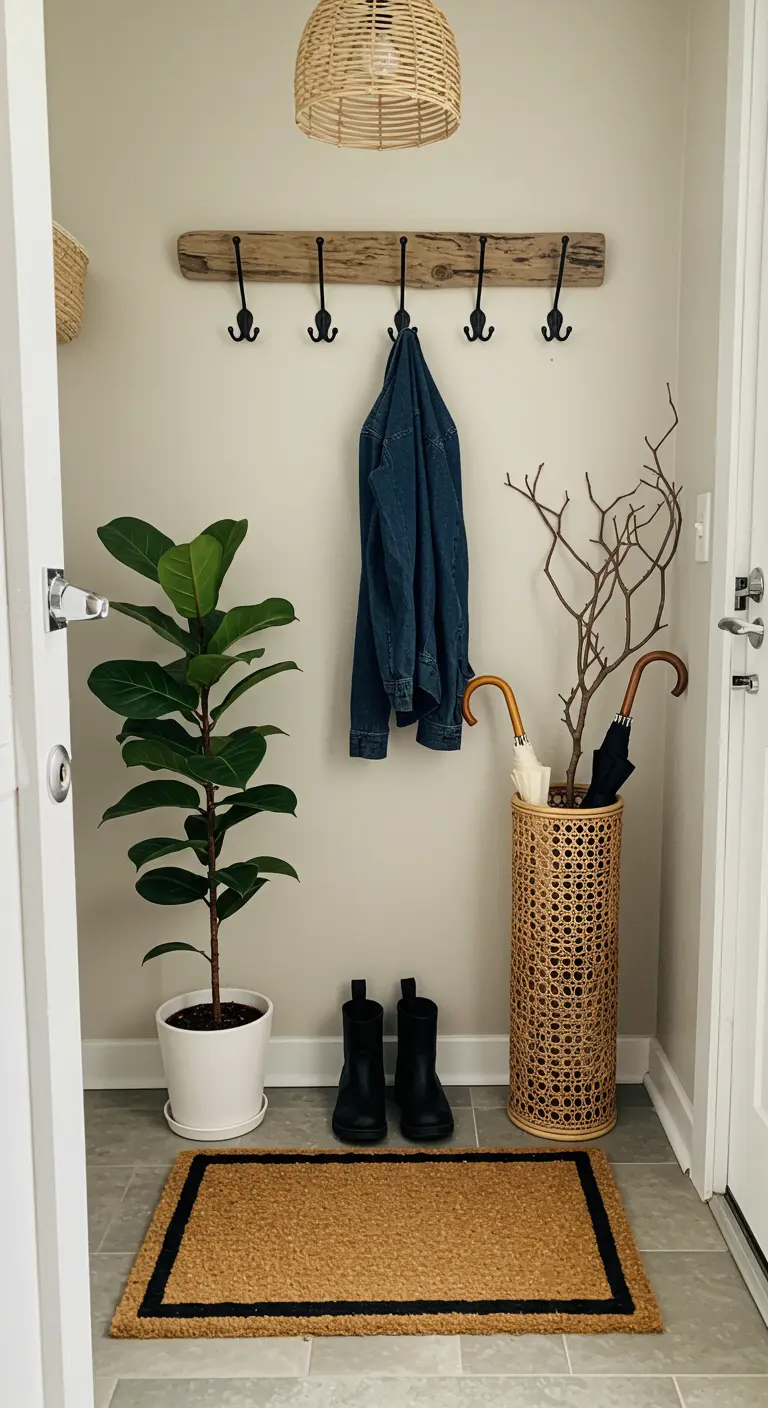
An entryway should serve its function beautifully. Combine natural materials for a space that is both organized and warm.
Mount a piece of reclaimed driftwood or a simple wood plank with sturdy hooks for coats and bags. It’s more organic and personal than a standard coat rack.
Use a tall, woven rattan basket as an umbrella stand, adding texture and a designated spot for wet items.
A fiddle-leaf fig in a clean white pot adds height and a welcoming touch of green, completing a perfectly styled, functional entryway.
27. Create an Immersive Office with Color Drenching

For a truly sophisticated and focused home office, try the technique of color drenching.
Paint the walls in a deep, moody green, and then use the exact same color for accessories like the task lamp and file organizers.
This monochromatic approach creates a seamless, immersive environment that minimizes visual distractions and feels incredibly chic.
A light wood desk and a green velvet chair provide textural contrast while staying within the harmonious color story. It’s a bold move seen in some luxe glam spaces.
28. Use an Open Bookshelf as an Airy Room Divider
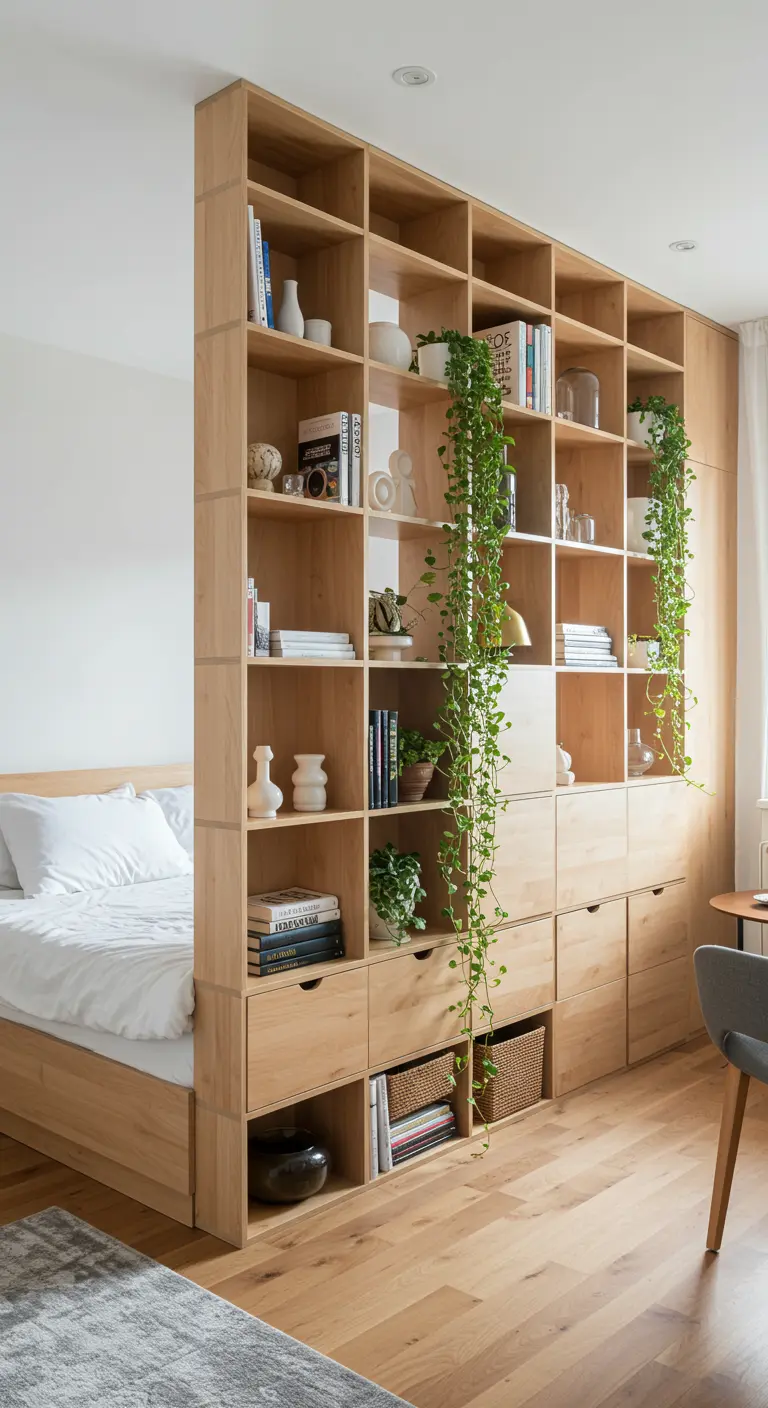
Define separate zones in a studio apartment without sacrificing light or a sense of openness.
Position a tall, open-back shelving unit to act as a partition between your bed and living area.
The structure creates a clear visual separation while allowing light to filter through. It also provides an enormous amount of storage and display space for books, ceramics, and trailing plants that add life to both ‘rooms’.
This is one of the most effective furniture layouts for small spaces.
29. Combine Corduroy and Chunky Knits for Comfort
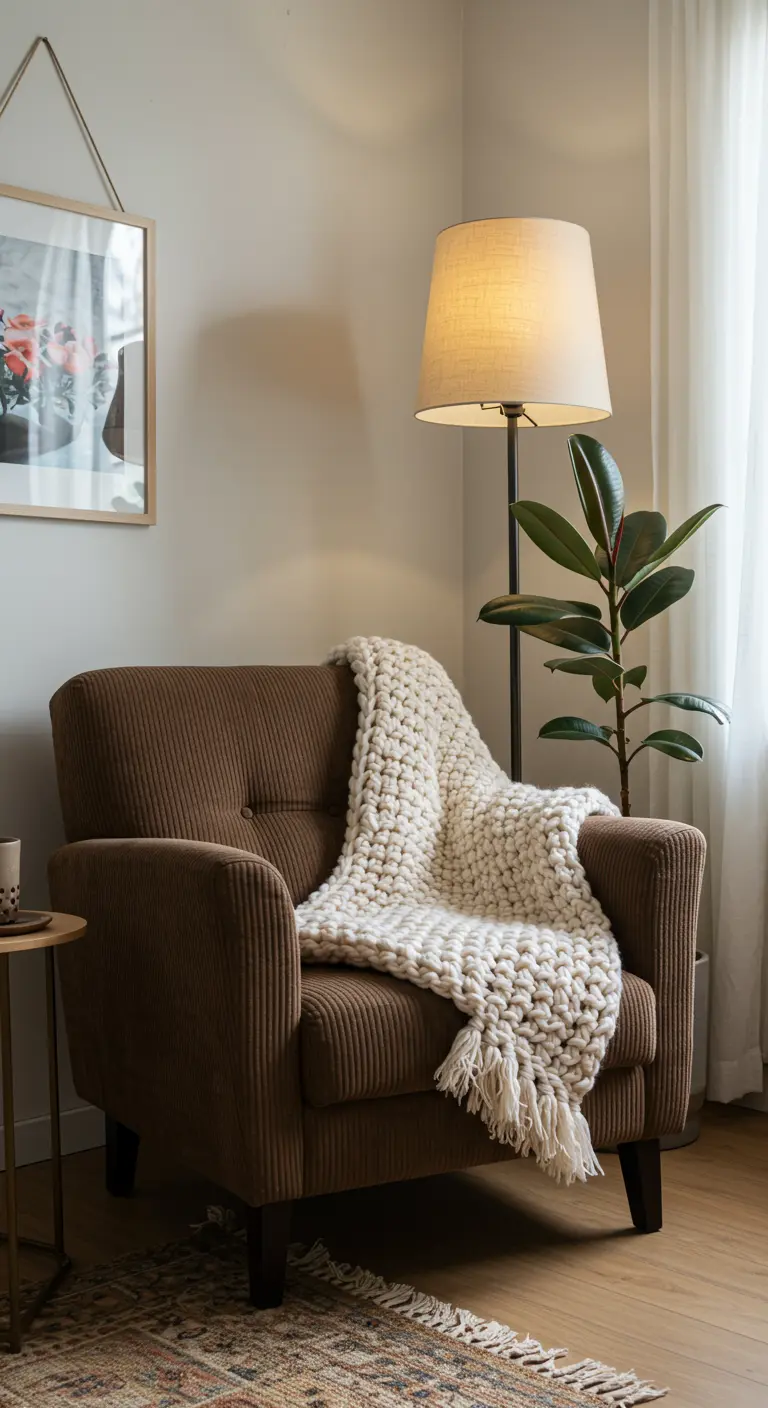
Create an irresistibly cozy reading chair by layering two distinct, comforting textures.
A soft, tufted armchair upholstered in wide-wale corduroy has a nostalgic, tactile appeal. The vertical lines of the fabric add subtle visual interest.
Drape a super chunky, hand-knit wool blanket over the arm. The contrast between the soft pile of the corduroy and the oversized weave of the blanket is pure tactile delight.
This combination embodies the spirit of Scandinavian winter retreats.
